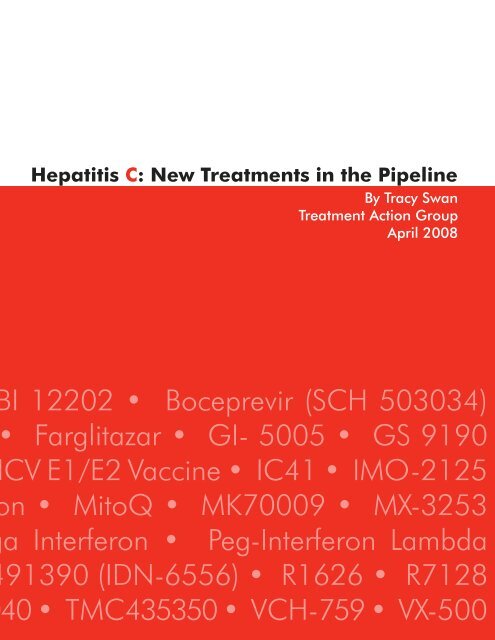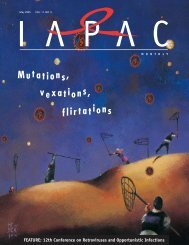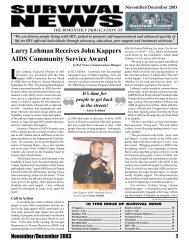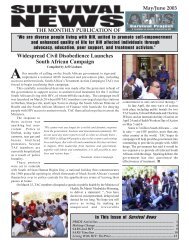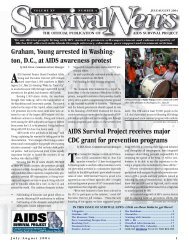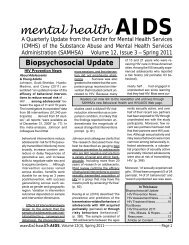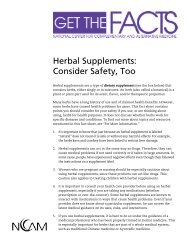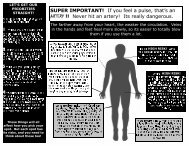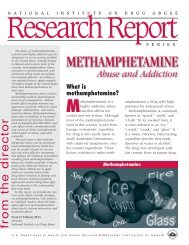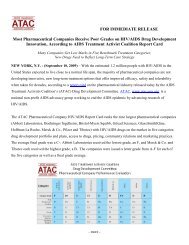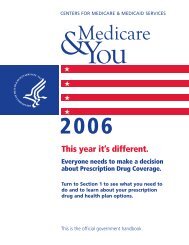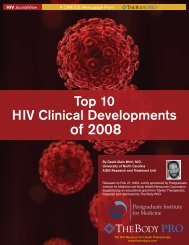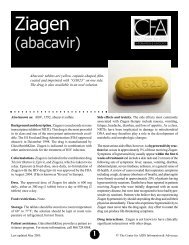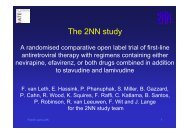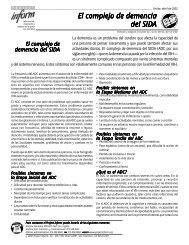Hepatitis C: New Treatments in the Pipeline - CD8 T cells - The Body
Hepatitis C: New Treatments in the Pipeline - CD8 T cells - The Body
Hepatitis C: New Treatments in the Pipeline - CD8 T cells - The Body
You also want an ePaper? Increase the reach of your titles
YUMPU automatically turns print PDFs into web optimized ePapers that Google loves.
<strong>Hepatitis</strong> C: <strong>New</strong> <strong>Treatments</strong> <strong>in</strong> <strong>the</strong> Pipel<strong>in</strong>e<br />
By Tracy Swan<br />
Treatment Action Group<br />
April 2008<br />
I 12202 • Boceprevir (SCH 503034)<br />
Farglitazar • GI- 5005 • GS 9190<br />
CV E1/E2 Vacc<strong>in</strong>e • IC41 • IMO-2125<br />
n • MitoQ • MK70009 • MX-3253<br />
a Interferon • Peg-Interferon Lambda<br />
91390 (IDN-6556) • R1626 • R7128<br />
40 • TMC435350 • VCH-759 • VX-500
About Treatment Action Group<br />
Treatment Action Group (TAG) is an <strong>in</strong>dependent AIDS research and policy th<strong>in</strong>k tank fight<strong>in</strong>g<br />
for better treatment, a vacc<strong>in</strong>e, and a cure for AIDS. TAG works to ensure that all people<br />
liv<strong>in</strong>g with HIV receive life sav<strong>in</strong>g treatment, care, and <strong>in</strong>formation.<br />
We are science-based treatment activists work<strong>in</strong>g to expand and accelerate vital research and<br />
effective community engagement with research and policy <strong>in</strong>stitutions.<br />
TAG catalyzes open collective action by all affected communities, scientists, and policymakers<br />
to end AIDS.<br />
Inside Cover: Thanks to <strong>the</strong> TAG board, staff, and generous donors. This work is possible<br />
because of your support.<br />
Thanks to Andrea Benzacar for edit<strong>in</strong>g; Lei Chou for design<strong>in</strong>g <strong>the</strong> cover, graphics, figures,<br />
and tables; Ca<strong>the</strong>r<strong>in</strong>e Coleman for proofread<strong>in</strong>g; Adam Fredericks for additional design<br />
and layout; and to Lynda Dee for her Foreword.<br />
Dedicated to: Phyllis Beck<br />
and<br />
Narelle Ellendon, Shari Foster, Ronni Marks, Sharon Phillips, Lorren Sandt, Sue Simon and<br />
Andi Thomas<br />
<strong>Hepatitis</strong> C: <strong>New</strong> <strong>Treatments</strong> <strong>in</strong> <strong>the</strong> Pipel<strong>in</strong>e<br />
© Treatment Action Group 2008<br />
ISBN -10: 0-97910-734-2<br />
ISBN -13: 978-0-97910-734-4<br />
Treatment Action Group<br />
611 Broadway Suite 308<br />
<strong>New</strong> York, NY 10012<br />
www.treatmentactiongroup.org<br />
P +1 212 253 7922<br />
F +1 212 253 7923
Table of Contents<br />
Foreword . . . . . . . . . . . . . . . . . . . . . . . . . . . . . . . . . . . . . . . . . . . . . . . . . . . . . . . . . . . . .3<br />
Introduction . . . . . . . . . . . . . . . . . . . . . . . . . . . . . . . . . . . . . . . . . . . . . . . . . . . . . . . . . . .7<br />
Oral Antivirals: HCV Protease and Polymerase Inhibitors . . . . . . . . . . . . . . . . . . . . . . . . .15<br />
O<strong>the</strong>r Antiviral Agents <strong>in</strong> Development . . . . . . . . . . . . . . . . . . . . . . . . . . . . . . . . . . . . . .24<br />
<strong>Hepatitis</strong> C NS5a Inhibitor . . . . . . . . . . . . . . . . . . . . . . . . . . . . . . . . . . . . . . . . . . . . .24<br />
<strong>Hepatitis</strong> C Alpha-Glucosidase Inhibitor . . . . . . . . . . . . . . . . . . . . . . . . . . . . . . . . . . .24<br />
Cyclophil<strong>in</strong> B Inhibitor . . . . . . . . . . . . . . . . . . . . . . . . . . . . . . . . . . . . . . . . . . . . . . . .24<br />
Nitazoxanide: <strong>the</strong> Upstart . . . . . . . . . . . . . . . . . . . . . . . . . . . . . . . . . . . . . . . . . . . . . . . .25<br />
Ribavir<strong>in</strong> Substitute . . . . . . . . . . . . . . . . . . . . . . . . . . . . . . . . . . . . . . . . . . . . . . . . . . . . .26<br />
Anti-Fibrotics . . . . . . . . . . . . . . . . . . . . . . . . . . . . . . . . . . . . . . . . . . . . . . . . . . . . . . . . . .27<br />
Caspase Inhibitors (GS 9450 and PF-03491390) . . . . . . . . . . . . . . . . . . . . . . . . . . . .27<br />
MitoQ . . . . . . . . . . . . . . . . . . . . . . . . . . . . . . . . . . . . . . . . . . . . . . . . . . . . . . . . . . . .27<br />
Farglitazar . . . . . . . . . . . . . . . . . . . . . . . . . . . . . . . . . . . . . . . . . . . . . . . . . . . . . . . . .27<br />
Immunomodulatory <strong>The</strong>rapies . . . . . . . . . . . . . . . . . . . . . . . . . . . . . . . . . . . . . . . . . . . . .28<br />
Toll-Like Receptor Agonists . . . . . . . . . . . . . . . . . . . . . . . . . . . . . . . . . . . . . . . . . . . . .28<br />
Mono- and Polyclonal Antibodies . . . . . . . . . . . . . . . . . . . . . . . . . . . . . . . . . . . . . . . .28<br />
Novel Interferon Formulations . . . . . . . . . . . . . . . . . . . . . . . . . . . . . . . . . . . . . . . . . . . . .29<br />
Preventive and <strong>The</strong>rapeutic Vacc<strong>in</strong>es . . . . . . . . . . . . . . . . . . . . . . . . . . . . . . . . . . . . . . . .31<br />
Terms For Response To HCV Treatment . . . . . . . . . . . . . . . . . . . . . . . . . . . . . . . . . . . . . . .34<br />
Resources . . . . . . . . . . . . . . . . . . . . . . . . . . . . . . . . . . . . . . . . . . . . . . . . . . . . . . . . . . . .35<br />
References . . . . . . . . . . . . . . . . . . . . . . . . . . . . . . . . . . . . . . . . . . . . . . . . . . . . . . . . . . .36<br />
1
Foreword<br />
I became an AIDS activist <strong>in</strong> 1986, when my husband was diagnosed with AIDS. He died<br />
from AIDS-related complications <strong>in</strong> 1987. While I’m very grateful I am not HIV-positive, last<br />
year I was diagnosed with hepatitis C. Just because I don’t now present as a party girl doesn’t<br />
mean I don’t have such risk factors <strong>in</strong> my background. In fact, <strong>the</strong> <strong>in</strong>sidious hepatitis C virus<br />
has apparently been loung<strong>in</strong>g <strong>in</strong> my liver for many years.<br />
I am also a cancer chemo<strong>the</strong>rapy and radiation survivor who is older and frailer than <strong>in</strong> days<br />
gone by. I know that I could never tolerate 48 weeks of pegylated <strong>in</strong>terferon and ribavir<strong>in</strong>.<br />
Moreover, like most of us, I cannot afford to be unemployed for any great length of time.<br />
Many HCV patients are <strong>in</strong> my age range and have o<strong>the</strong>r health issues. We need more<br />
effective, better-tolerated, and more easily adm<strong>in</strong>istered treatments.<br />
By 2007, we thought we had f<strong>in</strong>ally reached a turn<strong>in</strong>g po<strong>in</strong>t; we believed we had found a<br />
new paradigm for HCV treatment. If only that were <strong>the</strong> case. Although effective drugs are<br />
on <strong>the</strong> horizon, <strong>in</strong>terferon and ribavir<strong>in</strong> are still <strong>the</strong> ma<strong>in</strong>stay of HCV treatment, and <strong>the</strong><br />
community is rife with rumors that toxicities from some <strong>in</strong>itially promis<strong>in</strong>g new drugs may<br />
outweigh <strong>the</strong>ir benefits.<br />
Where do we go from here? <strong>The</strong> issues are both numerous and complex. Some patients are<br />
<strong>in</strong> a position to wait for new drugs, but many o<strong>the</strong>rs are not. Many patients cannot tolerate<br />
<strong>the</strong> current standard of care. Those with poor prognostic factors, such as people with HCV<br />
genotype 1 and a high viral load; HIV-positive people; African Americans; and people who<br />
have already developed serious liver damage are <strong>in</strong> big trouble, s<strong>in</strong>ce <strong>the</strong>y are less likely to<br />
respond to currently marketed HCV treatment.<br />
What about treatment-experienced patients who have already tried standard <strong>in</strong>terferon, with<br />
or without ribavir<strong>in</strong>? While some of <strong>the</strong>se patients do respond to pegylated <strong>in</strong>terferon plus<br />
ribavir<strong>in</strong>, <strong>the</strong> data on re-treatment response rates are discourag<strong>in</strong>g. <strong>The</strong>re are currently no<br />
approved treatments for people who do not respond to pegylated <strong>in</strong>terferon and ribavir<strong>in</strong>.<br />
<strong>The</strong>rapeutic vacc<strong>in</strong>es for HCV, or improvements <strong>in</strong> <strong>in</strong>terferon-based <strong>the</strong>rapy, may offer some<br />
hope <strong>in</strong> <strong>the</strong> near future.<br />
I believe that AIDS treatment activists have moved <strong>the</strong> field of HIV research forward swiftly,<br />
dramatically, and <strong>in</strong> a way that noth<strong>in</strong>g else has. We can do <strong>the</strong> same for hepatitis C. We<br />
know that we need comb<strong>in</strong>ations of small molecules such as protease and polymerase<br />
<strong>in</strong>hibitors to replace <strong>in</strong>terferon and/or ribavir<strong>in</strong>. Comb<strong>in</strong>ation regimens target<strong>in</strong>g different<br />
areas of <strong>the</strong> HCV life cycle, with different mechanisms of action, are necessary to forestall<br />
resistance and effectively combat HCV. Until this is possible, we can at least hope that new<br />
drugs will boost response rates, and decrease <strong>the</strong> amount of time people must spend on<br />
<strong>the</strong>se poorly tolerated treatments.<br />
HCV researchers would do well to reflect on, and apply scientific and pragmatic lessons<br />
from, HIV research. As an advocate for people with HIV, I can’t even utter <strong>the</strong> word resistance<br />
without acknowledg<strong>in</strong>g <strong>the</strong> harm done to so many people by poorly designed cl<strong>in</strong>ical trials,<br />
3
4<br />
and from non-strategic prescrib<strong>in</strong>g of HIV antiviral <strong>the</strong>rapy over <strong>the</strong> years. We will be work<strong>in</strong>g<br />
to remedy <strong>the</strong> misuse of effective treatment for years to come. We s<strong>in</strong>cerely hope that HCV<br />
researchers and cl<strong>in</strong>icians can learn from and avoid such mistakes.<br />
We can also learn from <strong>the</strong> successes <strong>in</strong> HIV research and treatment. <strong>The</strong> development<br />
of more effective treatments for HIV, <strong>in</strong>clud<strong>in</strong>g once-daily and one-pill regimens, speaks<br />
volumes about <strong>the</strong> resound<strong>in</strong>g success of well-funded modern medical research, and <strong>the</strong><br />
contribution of AIDS activists. We have brought a fresh perspective to <strong>the</strong> field by speak<strong>in</strong>g<br />
out at conferences and meet<strong>in</strong>gs without fear of los<strong>in</strong>g grant fund<strong>in</strong>g or tenure as a result<br />
of our criticisms. We have worked successfully to ensure that crucial fund<strong>in</strong>g is available<br />
to support successful research efforts. In <strong>the</strong> United States, we cont<strong>in</strong>ue to work as federal<br />
watchdogs by help<strong>in</strong>g to draft FDA accelerated-approval regulations and new drug-safety<br />
legislation. Activists cont<strong>in</strong>ue to participate <strong>in</strong> <strong>the</strong> design and oversight of cl<strong>in</strong>ical trials, and to<br />
dissem<strong>in</strong>ate <strong>in</strong>formation directly to affected communities.<br />
As advocates and activists, we clearly understand <strong>the</strong> ever-present tension between gett<strong>in</strong>g a<br />
drug approved and study<strong>in</strong>g <strong>the</strong> most strategic use of new drugs. But no one benefits from<br />
badly designed studies that rush a drug to market, particularly those that exclude African<br />
Americans, HIV-positive people, prior drug users, or o<strong>the</strong>r patient groups among whom<br />
HCV is common—and <strong>the</strong> unmet medical need is great. Such studies are impractical,<br />
counterproductive, and unacceptable, and will not be tolerated by <strong>the</strong> patient community or<br />
FDA. Remember, consumers are <strong>in</strong>cluded <strong>in</strong> FDA Advisory Panels.<br />
Companies need to be as forthcom<strong>in</strong>g as possible with <strong>the</strong> patient and provider communities<br />
about <strong>in</strong>cidence and management of long- and short-term side effects and o<strong>the</strong>r tolerability<br />
issues. Companies would do better to share such <strong>in</strong>formation honestly, and sooner ra<strong>the</strong>r<br />
than later. It’s not as if <strong>the</strong> facts don’t eventually surface. Build<strong>in</strong>g trust throughout <strong>the</strong> drug<br />
development process can only benefit sponsors, especially s<strong>in</strong>ce FDA is now armed with new<br />
drug safety laws to more effectively address long-term patient safety issues.<br />
Researchers and cl<strong>in</strong>icians would also do well to remember <strong>the</strong> heavy toll <strong>in</strong>terferon and<br />
ribavir<strong>in</strong> take on patients. Imply<strong>in</strong>g that patients are at fault for not be<strong>in</strong>g able to adhere<br />
to such a difficult regimen is misguided. Referr<strong>in</strong>g to such people as “noncompliant” is<br />
<strong>in</strong>sensitive and <strong>in</strong>sult<strong>in</strong>g. Instead, companies should work with researchers and <strong>the</strong> community<br />
to provide reasonable support services for patients undergo<strong>in</strong>g treatment with <strong>the</strong>se difficult<br />
regimens.<br />
Congress must also allocate new monies to assist patients, <strong>in</strong>stead of pitt<strong>in</strong>g disease groups<br />
aga<strong>in</strong>st each o<strong>the</strong>r to argue over <strong>in</strong>sufficient federal funds. Medic<strong>in</strong>e, especially medical<br />
research, is <strong>in</strong>extricably entw<strong>in</strong>ed with politics <strong>in</strong> <strong>the</strong> good old USA. Gett<strong>in</strong>g new money from<br />
Congress for what is essentially an unpopular, and often disenfranchised, population will<br />
undoubtedly be a daunt<strong>in</strong>g task. Our economy and our treasury leave a lot to be desired at<br />
this juncture. Hopefully, prioritization that puts people and life before war and death will be<br />
upon us after November 2008.
“Thank you” hardly reflects <strong>the</strong> appreciation I feel towards <strong>the</strong> Treatment Action Group (TAG),<br />
and my friend and colleague, Tracy Swan, <strong>the</strong> “Countess of Co<strong>in</strong>fection,” for <strong>the</strong>ir work<br />
with o<strong>the</strong>r activists, members of <strong>the</strong> medical and research communities, drug companies,<br />
and regulatory agencies. My long career as an AIDS activist conv<strong>in</strong>ces me and if we work<br />
toge<strong>the</strong>r, more effective, better-tolerated regimens will be available much more quickly.<br />
I wish you sweep<strong>in</strong>g and swift future success.<br />
Lynda Dee<br />
Co-founder of AIDS Action Baltimore.<br />
5
Introduction<br />
Prevent<strong>in</strong>g new <strong>in</strong>fections will not impact <strong>the</strong> predicted wave of morbidity and mortality<br />
from persons already <strong>in</strong>fected.<br />
While better and more affordable treatments are eagerly anticipated, much can be<br />
accomplished <strong>in</strong> <strong>the</strong> <strong>in</strong>terim.<br />
Affected countries must face <strong>the</strong> dilemmas at hand and give careful consideration to<br />
<strong>the</strong> array of available options for address<strong>in</strong>g and m<strong>in</strong>imiz<strong>in</strong>g <strong>the</strong> com<strong>in</strong>g wave of HCVrelated<br />
liver disease.<br />
Current strategies to reduce <strong>the</strong> long-term sequelae of chronic HCV <strong>in</strong>fection <strong>in</strong>clude<br />
identify<strong>in</strong>g <strong>in</strong>fected persons by test<strong>in</strong>g those at high risk and offer<strong>in</strong>g counsel<strong>in</strong>g,<br />
medical evaluation and treatment.<br />
—J.F. Perz and M.J. Alter<br />
Journal of Hepatology<br />
<strong>Hepatitis</strong> C virus (HCV) is a serious global health problem. Accord<strong>in</strong>g to <strong>the</strong> World Health<br />
Organization (WHO), which describes HCV as a “viral time bomb,” 130 million people<br />
have chronic hepatitis C, and 3 to 4 million more become <strong>in</strong>fected each year (WHO 2007).<br />
If untreated, or unresponsive to treatment, chronic HCV leads to cirrhosis <strong>in</strong> 20–30% of<br />
people. Each year, ~4% of people with hepatitis C-associated cirrhosis develop liver cancer,<br />
and ~6% will experience liver failure (Di Bisceglie 2000). WHO estimates that up to 75% of<br />
liver cancer and ~65% of liver transplants occurr<strong>in</strong>g <strong>in</strong> <strong>the</strong> developed world are attributable<br />
to chronic HCV <strong>in</strong>fection (WHO 2007).<br />
<strong>The</strong> current standard of care for HCV, pegylated <strong>in</strong>terferon and ribavir<strong>in</strong>, is not effective for<br />
approximately half of those who undergo it, and <strong>the</strong> side effects are often debilitat<strong>in</strong>g.<br />
<strong>The</strong> need for new <strong>the</strong>rapies for hepatitis C virus is more urgent than ever, particularly for<br />
a grow<strong>in</strong>g population of treatment-experienced people with serious liver damage. Results<br />
from HALT-C and SLAM-C—two <strong>in</strong>terferon ma<strong>in</strong>tenance trials for people with advanced liver<br />
damage—were an unexpected disappo<strong>in</strong>tment. Both reported that ma<strong>in</strong>tenance <strong>the</strong>rapy did<br />
not reduce fibrosis progression, hepatic decompensation, or liver-related mortality, leav<strong>in</strong>g no<br />
stopgap until new drugs are available (Di Bisceglie 2007; Sherman 2008). Without advances<br />
<strong>in</strong>, and broader access to, HCV treatment, liver-related mortality is expected to rise sharply <strong>in</strong><br />
<strong>the</strong> com<strong>in</strong>g years (Davis 2003).<br />
Better HCV treatment is critical for <strong>the</strong> estimated 4 to 5 million HIV/HCV-co<strong>in</strong>fected people<br />
(Alter 2006). HIV <strong>in</strong>creases <strong>the</strong> risk for and rate of hepatitis C progression. In fact, end-stage<br />
liver disease is now <strong>the</strong> lead<strong>in</strong>g cause of non-AIDS-related death among HIV-positive people<br />
<strong>in</strong> areas where antiretroviral <strong>the</strong>rapy is available (Weber 2006).<br />
7
8<br />
HCV treatment is far less effective for HIV/HCV-co<strong>in</strong>fected people (see Table 1. SVR from<br />
Cl<strong>in</strong>ical Trials by HCV Genotype and HIV Status [Treatment with PEG-IFN plus ribavir<strong>in</strong>],<br />
below). HIV/HCV-co<strong>in</strong>fected people tend to have more severe—often treatment-limit<strong>in</strong>g—<br />
side effects from HCV treatment, and many are not considered eligible for treatment.<br />
It is <strong>in</strong>credibly ironic that we have dramatically altered <strong>the</strong> prognosis for HIV—a currently<br />
<strong>in</strong>curable disease—only to see co<strong>in</strong>fected people dy<strong>in</strong>g from complications of hepatitis C,<br />
a disease that we can cure.<br />
Sponsors need to <strong>in</strong>itiate studies of novel HCV drugs <strong>in</strong> co<strong>in</strong>fected people as soon as it is safe<br />
to do so, preferably <strong>in</strong> parallel with phase III. Drug-drug <strong>in</strong>teraction studies with antiretroviral<br />
agents and o<strong>the</strong>r commonly used medications should be performed as early <strong>in</strong> development<br />
as possible to expedite <strong>the</strong>se important trials.<br />
Table 1 . SVR From Cl<strong>in</strong>ical Trials by HCV Genotype and HIV Status<br />
(Treatment with PEG-IFN plus ribavir<strong>in</strong>)<br />
Sources:<br />
Population SVR, Overall SVR, Genotype 1 SVR, Genotype 2&3<br />
HIV/HCV co<strong>in</strong>fected 27% – 44% 14% – 38% 53% – 73%<br />
HCV mono<strong>in</strong>fected 56% – 61% 42% – 44% 70% – 82%<br />
Carrat F, Bani-Sadr F, Pol S, et al. ANRS HCO2 RIBAVIC Study Team. Pegylated <strong>in</strong>terferon alfa-2b vs standard <strong>in</strong>terferon<br />
alfa-2b, plus ribavir<strong>in</strong>, for chronic hepatitis C <strong>in</strong> HIV-<strong>in</strong>fected patients: a randomized controlled trial. JAMA. 2004 Dec<br />
15;292(23):2839–48.<br />
Chung RT, Andersen J, Volberd<strong>in</strong>g P, et al. AIDS Cl<strong>in</strong>ical Trials Group A5071 Study Team. Peg<strong>in</strong>terferon Alfa-2a plus ribavir<strong>in</strong> versus<br />
<strong>in</strong>terferon alfa-2a plus ribavir<strong>in</strong> for chronic hepatitis C <strong>in</strong> HIV-co<strong>in</strong>fected persons. N Engl J Med. 2004 Jul 29;351(5):451–9.<br />
Fried MW, Shiffman ML, Reddy KR, et al. Peg<strong>in</strong>terferon alfa-2a plus ribavir<strong>in</strong> for chronic hepatitis C virus <strong>in</strong>fection. N Engl J<br />
Med. 2002 Sep 26;347(13):975–82.<br />
Laguno M, Murillas J, Blanco JL, et al. Peg<strong>in</strong>terferon alfa-2b plus ribavir<strong>in</strong> compared with <strong>in</strong>terferon alfa-2b plus ribavir<strong>in</strong> for<br />
treatment of HIV/HCV co-<strong>in</strong>fected patients. AIDS. 2004 Sep 18(13):F27–36.<br />
Manns MP, McHutchison JG, Gordon SC, et al. Peg<strong>in</strong>terferon alfa-2b plus ribavir<strong>in</strong> compared with <strong>in</strong>terferon alfa-2b plus<br />
ribavir<strong>in</strong> for <strong>in</strong>itial treatment of chronic hepatitis C: a randomised trial. Lancet. 2001 Sep 22;358(9286):958–65.<br />
Torriani FJ, Rodriguez-Torres M, Rockstroh JK, et al. APRICOT Study Group. Peg<strong>in</strong>terferon Alfa-2a plus ribavir<strong>in</strong> for chronic<br />
hepatitis C virus <strong>in</strong>fection <strong>in</strong> HIV-<strong>in</strong>fected patients. N Engl J Med. 2004 Jul 29;351(5):438–50.<br />
SETBACKS<br />
2007 was a year of many setbacks. <strong>The</strong> development of several candidates was halted due<br />
to toxicity, <strong>in</strong>sufficient efficacy, and/or f<strong>in</strong>ancial concerns: NM 283 and HCV-796 (polymerase<br />
<strong>in</strong>hibitor candidates from Idenix and Wyeth/Viropharma); ACH-806 /GS 9132 (an HCV<br />
protease <strong>in</strong>hibitor co-developed by Achillion/Gilead); AVI-4065 (an antisense drug from<br />
AVI BioPharma); Actilon (a TLR9 antagonist from Coley pharmaceuticals); and VGX-410 C<br />
(an oral IRES <strong>in</strong>hibitor from VGX Pharmaceuticals). Development of MAXY-alpha (a novel<br />
<strong>in</strong>terferon formulation co-developed by Roche and Maxygen) was put on hold and is unlikely<br />
to resume. XLT Pharmaceuticals suspended development of XTL-2125, a polymerase <strong>in</strong>hibitor,<br />
and XTL 6865, a monoclonal antibody.
Doses of promis<strong>in</strong>g candidates have been modified due to safety issues. Gilead is go<strong>in</strong>g<br />
with a lower dose of GS 9190, an HCV polymerase <strong>in</strong>hibitor. Dur<strong>in</strong>g <strong>the</strong> phase III study of<br />
Albuferon (a longer-last<strong>in</strong>g formulation of <strong>in</strong>terferon be<strong>in</strong>g developed by Human Genome<br />
Sciences and Novartis), a Data Safety Monitor<strong>in</strong>g Board (DSMB) discont<strong>in</strong>ued <strong>the</strong> highest<br />
dos<strong>in</strong>g arm, due to pulmonary adverse events.<br />
A drastic shift <strong>in</strong> <strong>the</strong> HCV treatment paradigm will not occur for several years, s<strong>in</strong>ce <strong>in</strong>terferonfree<br />
regimens are years away, and ribavir<strong>in</strong> is still a necessary component of HCV treatment.<br />
Recent research has underscored its value for prevent<strong>in</strong>g viral breakthrough and lower<strong>in</strong>g<br />
relapse rates. Given emerg<strong>in</strong>g concerns with new <strong>the</strong>rapies—toxicity, drug-drug <strong>in</strong>teractions,<br />
resistance, and adherence—it is especially disappo<strong>in</strong>t<strong>in</strong>g to rema<strong>in</strong> saddled with <strong>the</strong> current<br />
standard of care.<br />
HCV treatment uptake will not <strong>in</strong>crease significantly until comb<strong>in</strong>ations of more effective, less<br />
toxic, more affordable drugs are available, particularly for people who are unlikely to respond<br />
to, or unable to tolerate, <strong>the</strong> current standard of care. Accord<strong>in</strong>g to Data Monitor, <strong>in</strong> 2006,<br />
sales of pegylated <strong>in</strong>terferon and ribavir<strong>in</strong>—<strong>the</strong> current standard of care for HCV—reached<br />
$2.5 billion <strong>in</strong> <strong>the</strong> U.S. and Europe; but sales are projected to <strong>in</strong>crease by only $1.5 billion<br />
by 2010, reflect<strong>in</strong>g <strong>the</strong> limitations of <strong>the</strong> current treatment. Better HCV drugs will be a jackpot<br />
for <strong>the</strong> pharmaceutical <strong>in</strong>dustry.<br />
PROGRESS<br />
<strong>The</strong> efficacy of HCV treatment improved with <strong>the</strong> advent of pegylated <strong>in</strong>terferon-based<br />
regimens, and <strong>the</strong>re has been additional progress s<strong>in</strong>ce <strong>the</strong>n. A steady parade of new agents<br />
is mov<strong>in</strong>g forward <strong>in</strong>to precl<strong>in</strong>ical and cl<strong>in</strong>ical development; researchers toil <strong>in</strong> state-of-<strong>the</strong>art<br />
laboratories, develop<strong>in</strong>g new drugs, attempt<strong>in</strong>g to identify correlates of spontaneous viral<br />
clearance and response to HCV treatment, and characteriz<strong>in</strong>g resistance to new HCV antiviral<br />
drugs. Activists are work<strong>in</strong>g with regulators, researchers, and <strong>in</strong>dustry to develop guidance for<br />
swift, strategic, and <strong>in</strong>clusive drug development.<br />
More effective, shorter-course HCV treatment is on <strong>the</strong> horizon. <strong>The</strong> pipel<strong>in</strong>e is full of<br />
second-generation candidates and new approaches, such as RNA <strong>in</strong>terference, to thwart<br />
HCV replication. Promis<strong>in</strong>g results have been reported from phase II studies of Vertex’s HCV<br />
protease <strong>in</strong>hibitor, telaprevir, and from Romark’s phase II study of nitazoxanide, an approved<br />
anti-protozoal agent. Data are flow<strong>in</strong>g <strong>in</strong> from phase I studies of protease and polymerase<br />
<strong>in</strong>hibitors. In <strong>the</strong> future, coformulated versions of <strong>the</strong>se oral drugs may be possible.<br />
9
10<br />
LESSONS LEARNED<br />
<strong>The</strong> remarkable successes, complexities, and challenges <strong>in</strong> HIV research and cl<strong>in</strong>ical care<br />
offer valuable lessons for HCV drug development, care, and treatment.<br />
Research Issues: Trial Design and Study Populations<br />
• Trials need to be designed to identify <strong>the</strong>rapeutic strategies, as well as to ga<strong>in</strong> approval<br />
for a s<strong>in</strong>gle agent.<br />
• As with HIV, a comb<strong>in</strong>ation of drugs, target<strong>in</strong>g different steps <strong>in</strong> <strong>the</strong> HCV life cycle,<br />
is needed to ward off resistance. Cross-company collaboration on multi-agent trials<br />
(<strong>in</strong>volv<strong>in</strong>g both approved and experimental drugs) is needed to advance <strong>the</strong> field.<br />
Regulators can facilitate <strong>the</strong>se collaborations by develop<strong>in</strong>g regulatory guidance for<br />
multi-experimental agent trials.<br />
• Sponsors must study safety, efficacy, and tolerability of new HCV treatments and<br />
treatment regimens <strong>in</strong> cl<strong>in</strong>ically relevant populations prior to approval. This means<br />
explor<strong>in</strong>g new <strong>the</strong>rapies <strong>in</strong> populations that are hard to treat and may have urgent,<br />
unmet needs, such as: HIV/HCV-co<strong>in</strong>fected people; African Americans; people with<br />
genotype 1 and/or high basel<strong>in</strong>e HCV RNA; transplant candidates and recipients;<br />
people with advanced liver damage; current and former drug users; and <strong>the</strong> rapidly<br />
grow<strong>in</strong>g population of treatment-experienced people.<br />
• <strong>The</strong>re are practical and f<strong>in</strong>ancial reasons for sponsors to conduct registration trials <strong>in</strong><br />
“real-life” populations. From a regulatory perspective, “... it is important that a good<br />
sampl<strong>in</strong>g of <strong>the</strong> patients who will receive <strong>the</strong> drug be part of registration trials” (Dr.<br />
Debra Birnkrant, FDA, 2006). More <strong>in</strong>clusive trials will enroll more quickly and are more<br />
feasible, because <strong>the</strong> number of cherry-picked, o<strong>the</strong>rwise completely healthy, treatmentnaïve<br />
patients available to participate <strong>in</strong> HCV treatment trials is dw<strong>in</strong>dl<strong>in</strong>g. Secur<strong>in</strong>g a<br />
broader <strong>in</strong>dication facilitates drug sales, s<strong>in</strong>ce <strong>in</strong>surers have begun to limit access to offlabel<br />
use of drugs, and it is likely that restrictions will <strong>in</strong>crease <strong>in</strong> <strong>the</strong> future.<br />
• <strong>The</strong>re are specific issues <strong>in</strong>volved <strong>in</strong> design<strong>in</strong>g re-treatment trials for people who did not<br />
respond to pegylated <strong>in</strong>terferon and ribavir<strong>in</strong>.<br />
• Re-treat<strong>in</strong>g <strong>the</strong>se non-responders with an identical regimen has yielded SVR rates of<br />
~3% (Rustgi 2008). Future trials <strong>in</strong> this group of non-responders should offer more than<br />
one novel agent, preferably <strong>in</strong> a factorial design when possible. Until comb<strong>in</strong>ations of<br />
drugs are available, <strong>the</strong>se re-treatment trials need to <strong>in</strong>corporate successful re-treatment<br />
strategies <strong>in</strong>to <strong>the</strong>ir design—especially <strong>in</strong>to <strong>the</strong> control arm—so that participants have<br />
<strong>the</strong> best possible chance to achieve susta<strong>in</strong>ed virological response (SVR; see Terms for<br />
Response to HCV Treatment, page 34; see also Table 2, page 11. Re-treatment Trials <strong>in</strong><br />
Non-Responders to at Least 12 Weeks of PEG-IFN and Ribavir<strong>in</strong>: Strategies and SVR).<br />
<strong>The</strong>se strategies may <strong>in</strong>volve extend<strong>in</strong>g <strong>the</strong> duration of treatment, or us<strong>in</strong>g a different<br />
formulation of <strong>in</strong>terferon, or a higher dose of ribavir<strong>in</strong>.
Table 2 . Re-treatment Trials <strong>in</strong> Non-Responders to at Least 12 Weeks of<br />
PEG-IFN and Ribavir<strong>in</strong>: Strategies and SVR<br />
REPEAT ~90% HCV Genotype 1<br />
Treatment Strategy SVR Comments<br />
Double Dose Induction, Standard Duration<br />
360μg PEG-IFN for 12 weeks, followed by<br />
180μg PEG-IFN + RBV for 36 weeks<br />
Double Dose Induction, Extended Duration<br />
360μg PEG-IFN for 12 weeks, followed by<br />
180μg PEG-IFN + RBV for 60 weeks<br />
Standard Dose, Standard Duration<br />
180μg PEG-IFN + RBV for 48 weeks<br />
Standard Dose, Extended Duration<br />
180μg PEG-IFN + RBV for 72 weeks<br />
11/156 (7%) Induction dos<strong>in</strong>g did not make a significant<br />
difference <strong>in</strong> SVR<br />
14/156 (9%) experienced serious adverse events<br />
7/156 (4%) discont<strong>in</strong>ued for safety<br />
52/317 (16%) Extend<strong>in</strong>g duration of treatment <strong>in</strong>creased SVR,<br />
lowered relapse rate<br />
33/317 (10%) experienced serious adverse events<br />
37/317 (12%) discont<strong>in</strong>ued for safety<br />
27/313 (9%) 33/313 (11%) experienced serious adverse events<br />
20/313 (6%) discont<strong>in</strong>ued for safety<br />
22/156 (14%) 28/156 (18%) experienced serious adverse events<br />
18/156 (12%) discont<strong>in</strong>ued for safety<br />
DIRECT (Daily Dose Consensus Interferon and Ribavir<strong>in</strong>: Efficacy of Comb<strong>in</strong>ed <strong>The</strong>rapy) ~95% HCV genotype 1<br />
Control: no treatment after lead-<strong>in</strong> SVR 12 = 0% Participants <strong>in</strong> <strong>the</strong> control arm eligible for<br />
roll-over study<br />
Interferon alfacon 9μg/day + RBV for 48 weeks SVR 12 =<br />
5.3%<br />
Interferon alfacon 15μg/day + RBV for 48 weeks SVR 12 =<br />
9.5%<br />
<strong>The</strong> German Consensus Interferon Multicenter Study (Interim Results) 96% HCV genotype 1<br />
Low-dose <strong>in</strong>duction 9/9<br />
Interferon alfacon 9μg/day for 16 weeks, followed by<br />
Interferon alfacon 9μg/day + weight-based RBV<br />
for 32-56 weeks<br />
High-dose <strong>in</strong>duction 27/18/9<br />
Interferon alfacon 27μg/day for 4 weeks, followed by<br />
Interferon alfacon 18μg/day for 12 weeks, followed<br />
by Interferon alfacon 9μg/day + weight-based RBV for<br />
32–56 weeks<br />
14% discont<strong>in</strong>ued for adverse events<br />
14% discont<strong>in</strong>ued for adverse events<br />
13% SVR differed by orig<strong>in</strong>al regimen:<br />
13% for PEG-alfa 2b vs. 19% for PEG alfa-2a<br />
19% SVR differed by orig<strong>in</strong>al regimen:<br />
19% for PEG-alfa 2b vs. 27% for PEG alfa-2a<br />
Although treatment discont<strong>in</strong>uation did not differ<br />
by treatment arm, <strong>the</strong> high-dose <strong>in</strong>duction was<br />
less tolerable<br />
Sources:<br />
Jensen DM, Freilich B, Andreone P, et al. (abstract LB4) Pegylated <strong>in</strong>terferon alfa-2a (40KD) plus ribavir<strong>in</strong> (RBV) <strong>in</strong> prior nonresponders<br />
to pegylated <strong>in</strong>terferon alfa-2b (12KD)/RBV: f<strong>in</strong>al efficacy and safety outcomes of <strong>the</strong> REPEAT study. 58th Annual<br />
Meet<strong>in</strong>g of <strong>the</strong> American Association for <strong>the</strong> Study of Liver Diseases. Boston, MA. November 2–6, 2007.<br />
Bacon B, Regev A, Ghalib RH, et al. (abstract 168) <strong>The</strong> DIRECT trial (Daily-Dose Consensus Interferon and Ribavir<strong>in</strong>: Efficacy of<br />
Comb<strong>in</strong>ed <strong>The</strong>rapy): treatment of non-responders to previous pegylated <strong>in</strong>terferon plus ribavir<strong>in</strong>: susta<strong>in</strong>ed virologic response<br />
data. 58th Annual Meet<strong>in</strong>g of <strong>the</strong> American Association for <strong>the</strong> Study of Liver Diseases. Boston, MA. November 2–6, 2007.<br />
11
12<br />
Kaiser S, Boecher W, Schlaak JF, et al. (abstract 1306) Treatment of Peg<strong>in</strong>terferon/Ribavir<strong>in</strong> Nonresponders with Daily Dos<strong>in</strong>g<br />
of Consensus Interferon and Ribavir<strong>in</strong> - Prelim<strong>in</strong>ary Results of <strong>the</strong> German Consensus Interferon Multicenter Study. 58th<br />
Annual Meet<strong>in</strong>g of <strong>the</strong> American Association for <strong>the</strong> Study of Liver Diseases. Boston, MA. November 2–6, 2007.<br />
Care and Treatment Issues: Resistance/Adherence, Appreciat<strong>in</strong>g Toxicity,<br />
Multidiscipl<strong>in</strong>ary Systems, and HCV Treatment Guidel<strong>in</strong>es<br />
• Resistance to HCV protease and polymerase <strong>in</strong>hibitors can develop rapidly. <strong>The</strong> first<br />
generation of HCV protease <strong>in</strong>hibitors to reach phase II must be taken three times a day,<br />
every eight hours—a dos<strong>in</strong>g schedule associated with poor adherence (Claxton 2001).<br />
• Liver specialists may be unaccustomed to provid<strong>in</strong>g adherence support. Methods<br />
that are proven to promote adherence—such as patient support and education, and<br />
pillboxes—should be <strong>in</strong>corporated <strong>in</strong>to cl<strong>in</strong>ical trials and cl<strong>in</strong>ical practice (Peterson<br />
2007; Rueda 2006).<br />
• Liver specialists will need <strong>in</strong>formation on <strong>the</strong> importance and <strong>in</strong>terpretation of resistance<br />
test<strong>in</strong>g to optimize HCV treatment outcomes.<br />
• When target<strong>in</strong>g a virus, <strong>the</strong> patient often seems to get <strong>in</strong> <strong>the</strong> way. It is a mistake to<br />
underestimate <strong>the</strong> importance of tolerability, which is sometimes overlooked by eager<br />
researchers <strong>in</strong> <strong>the</strong>ir quest to cure hepatitis C.<br />
• In <strong>the</strong> United States, <strong>the</strong> majority of people with chronic hepatitis C are 40 to 59 years<br />
old. Many have o<strong>the</strong>r chronic health problems, family responsibilities, and demand<strong>in</strong>g<br />
jobs that make it difficult or impossible for <strong>the</strong>m to tolerate <strong>the</strong> current standard of care,<br />
result<strong>in</strong>g <strong>in</strong> low rates of treatment uptake and completion.<br />
• <strong>The</strong>rapeutic advances must be accompanied by health-care delivery systems suited to<br />
<strong>the</strong> needs of multiply diagnosed persons. <strong>The</strong>se systems need to be created now to meet<br />
current needs and <strong>in</strong> anticipation of future improvements <strong>in</strong> HCV treatment.<br />
• It is likely that <strong>the</strong> standard of care for HCV will become somewhat of a mov<strong>in</strong>g target <strong>in</strong><br />
<strong>the</strong> com<strong>in</strong>g years. Conven<strong>in</strong>g an expert, cross-discipl<strong>in</strong>ary panel to develop and update<br />
HCV treatment guidel<strong>in</strong>es will optimize treatment and avert <strong>the</strong>rapeutic chaos.<br />
Community Involvement<br />
• S<strong>in</strong>ce <strong>the</strong> late 1980s, when <strong>the</strong>y demanded to be treated as partners <strong>in</strong> HIV research,<br />
people with HIV/AIDS and treatment activists have become vital participants <strong>in</strong> HIV<br />
drug development. <strong>The</strong>y serve on scientific peer-review committees, protocol teams,<br />
regulatory advisory committees, and treatment guidel<strong>in</strong>es panels. Activists work with<br />
sponsors of public and private research, and participate <strong>in</strong> <strong>the</strong> design and oversight of<br />
cl<strong>in</strong>ical trials.
• HCV researchers have much to ga<strong>in</strong> by work<strong>in</strong>g more closely with activists and<br />
community members. Many br<strong>in</strong>g an often-overlooked, practical perspective to areas<br />
rang<strong>in</strong>g from drug development to delivery of care and treatment. Cont<strong>in</strong>u<strong>in</strong>g to<br />
exclude members of <strong>the</strong> HCV community from contribut<strong>in</strong>g as fully respected partners<br />
<strong>in</strong> hepatitis C research is counterproductive and shortsighted.<br />
ACCESS<br />
Our challenge is to ensure that advances <strong>in</strong> HCV treatment are available to all who need<br />
<strong>the</strong>m, s<strong>in</strong>ce a majority of people with hepatitis C live <strong>in</strong> poverty. <strong>Hepatitis</strong> C is a disease that<br />
reflects and magnifies global social and economic <strong>in</strong>equality. Limited—or <strong>the</strong> complete lack<br />
of—access to HCV prevention, care, and treatment render <strong>the</strong>se virtually useless to millions of<br />
people with chronic hepatitis C. We can decrease HCV-related morbidity and mortality if we:<br />
• Ensure adequate coverage of additional costs associated with HCV care and<br />
treatment, such as diagnostic test<strong>in</strong>g and o<strong>the</strong>r lab work; nurs<strong>in</strong>g and cl<strong>in</strong>ic staff time;<br />
management of side effects; and mental health care;<br />
• Anticipate future costs, such as resistance test<strong>in</strong>g and adherence support services, and<br />
provide fund<strong>in</strong>g; and<br />
• Work to develop a reasonable, high-volume, low-profit framework for global pric<strong>in</strong>g of<br />
HCV drugs and diagnostics.<br />
13
14<br />
Figure 1 . Targets for HCV Drugs<br />
Translation &<br />
polyprote<strong>in</strong> process<strong>in</strong>g<br />
Nucleocapsid<br />
Envelope<br />
RNA<br />
NS3/4 protease <strong>in</strong>hibitors<br />
(+) RNA<br />
Receptor b<strong>in</strong>d<strong>in</strong>g<br />
and endocytosis<br />
Fusion and<br />
uncoat<strong>in</strong>g<br />
Transport<br />
and release<br />
Viral assembly<br />
Alpha-glucosidase <strong>in</strong>hibitors<br />
RNA replication<br />
NS5B polymerase <strong>in</strong>hibitors,<br />
Cyclophil<strong>in</strong> <strong>in</strong>hibitors
Oral Antivirals: HCV Protease and Polymerase Inhibitors<br />
<strong>The</strong> NS3-4A ser<strong>in</strong>e protease enzyme and <strong>the</strong> NS5B RNA-dependent RNA polymerase enzyme<br />
are primary targets for oral antiviral agents, s<strong>in</strong>ce both enzymes are essential for HCV<br />
replication. Unfortunately, HCV’s high replication rate—billions of copies per day—leads to<br />
drug resistance. In fact, mutations <strong>in</strong> HCV’s protease and polymerase doma<strong>in</strong>s have already<br />
been characterized, both <strong>in</strong> vitro and <strong>in</strong> vivo (Le Pogam 2006; Zhou 2008).<br />
<strong>The</strong> consequences of acquir<strong>in</strong>g HCV drug resistance are currently unknown; it may be<br />
a transient phenomenon s<strong>in</strong>ce HCV does not <strong>in</strong>tegrate <strong>in</strong>to <strong>the</strong> host cell’s genome. But<br />
it is possible that mutations may confer resistance to an agent—or an entire class of<br />
agents. Drug-resistant HCV may be less fit, but a lower replication capacity will be a scant<br />
consolation for people who have acquired a treatment-resistant virus (Mo 2005; Zhou 2007).<br />
Studies of people who have developed resistance to HCV antivirals should be performed <strong>in</strong><br />
order to fully understand <strong>the</strong> cl<strong>in</strong>ical implications of HCV drug resistance.<br />
As with HIV, hepatitis C treatment requires a comb<strong>in</strong>ation of drugs that target different steps<br />
<strong>in</strong> <strong>the</strong> replication cycle. Sponsors will need to collaborate on multi-agent trials to identify and<br />
optimize treatment strategies. Unfortunately, we must wait until <strong>the</strong>re are enough drugs at<br />
similar stages of development, while push<strong>in</strong>g to facilitate <strong>the</strong>se studies through dialogues with<br />
<strong>in</strong>dustry, researchers, and regulators.<br />
HCV Protease Inhibitors<br />
BILN-2061, an HCV protease <strong>in</strong>hibitor from Boehr<strong>in</strong>ger Ingleheim, was <strong>the</strong> first of its class.<br />
Although BILN-2061 was discont<strong>in</strong>ued due to cardiotoxicity <strong>in</strong> animals, proof of concept was<br />
established (Lamarre 2003). S<strong>in</strong>ce <strong>the</strong>n, <strong>the</strong>re have been high hopes for HCV protease <strong>in</strong>hibitors,<br />
and several are <strong>in</strong> cl<strong>in</strong>ical development. So far, all have been studied <strong>in</strong> people with HCV<br />
genotype 1. Telaprevir, an HCV protease <strong>in</strong>hibitor be<strong>in</strong>g co-developed by Vertex and Tibotec, is<br />
also be<strong>in</strong>g studied <strong>in</strong> people with genotypes 2, 3, and 4 <strong>in</strong> trials outside of <strong>the</strong> U.S.<br />
HCV Protease Inhibitors (oral)<br />
Product Manufacturer Status<br />
BI 12202* Boehr<strong>in</strong>ger Ingleheim Phase I<br />
Boceprevir (SCH 503034) Scher<strong>in</strong>g Plough Phase II<br />
ITMN-191 (R7227) Intermune/Roche Phase Ib<br />
MK-7009 Merck/Isis Phase Ib<br />
Telaprevir (VX-950) Vertex Phase III<br />
TMC 435350 Medivir/Tibotec Phase II<br />
VX-500 Vertex Phase Ia<br />
* Information not confirmed by sponsor<br />
15
16<br />
• BI 12202<br />
Boehr<strong>in</strong>ger Ingleheim has not released <strong>in</strong>formation about <strong>the</strong>ir HCV protease <strong>in</strong>hibitor<br />
candidate.<br />
• Boceprevir<br />
Scher<strong>in</strong>g has conducted a pair of phase II studies of boceprevir, <strong>the</strong>ir HCV protease <strong>in</strong>hibitor.<br />
<strong>The</strong>ir dose-f<strong>in</strong>d<strong>in</strong>g study assessed safety and efficacy of 100, 200, and 400 mg/TID (three<br />
times daily), plus pegylated <strong>in</strong>terferon, with or without ribavir<strong>in</strong>, <strong>in</strong> non-responders with HCV<br />
genotype 1. African Americans were <strong>in</strong>itially excluded from this study, until an additional,<br />
higher-dose arm (boceprevir 800 mg/TID) was added. <strong>The</strong> company permitted 15 African<br />
Americans to enroll <strong>in</strong> <strong>the</strong> higher-dose arm, due <strong>in</strong> part to community outrage.<br />
<strong>The</strong> protocol was subsequently amended, when concerns about lack of response <strong>in</strong> <strong>the</strong><br />
low-dose arms led <strong>the</strong> Data and Safety Monitor<strong>in</strong>g Board (DSMB) to recommend that all<br />
virological responders be given <strong>the</strong> 800 mg dose plus ribavir<strong>in</strong>.<br />
Scher<strong>in</strong>g is also study<strong>in</strong>g safety and efficacy of boceprevir plus pegylated <strong>in</strong>terferon and<br />
ribavir<strong>in</strong> <strong>in</strong> treatment-naïve people with HCV genotype 1 <strong>in</strong> an ongo<strong>in</strong>g trial. HCV SPRINT-1<br />
(Ser<strong>in</strong>e Protease Inhibitor <strong>The</strong>rapy-1) is a seven-arm study, evaluat<strong>in</strong>g 800 mg of boceprevir<br />
TID. Notably, participants <strong>in</strong> two arms of HCV SPRINT-1 are receiv<strong>in</strong>g a lower-than-usual<br />
dose of ribavir<strong>in</strong> (400–1,000 mg/day, ra<strong>the</strong>r than 800–1,400 mg/day accord<strong>in</strong>g to weight).<br />
In October 2007, Scher<strong>in</strong>g issued a press release announc<strong>in</strong>g <strong>the</strong> top-l<strong>in</strong>e results of <strong>the</strong>ir<br />
non-responder study, and <strong>in</strong>terim results from HCV SPRINT-1, <strong>the</strong> treatment-naïve trial. More<br />
details are expected at <strong>the</strong> European Association for <strong>the</strong> Study of <strong>the</strong> Liver (EASL) meet<strong>in</strong>g <strong>in</strong><br />
April 2008. Until <strong>the</strong>n, a hodgepodge of regimens, doses, and treatment durations make it<br />
difficult to <strong>in</strong>terpret <strong>the</strong> results, which ranged from 7% to 14% SVR <strong>in</strong> <strong>the</strong> boceprevir arms,<br />
versus 2% of those <strong>in</strong> <strong>the</strong> control arm (who were re-treated with pegylated <strong>in</strong>terferon and<br />
ribavir<strong>in</strong>). Headache, nausea, fatigue, and anemia were <strong>the</strong> most commonly reported<br />
adverse events.<br />
Interim results from HCV SPRINT-1, <strong>the</strong> treatment-naïve study, are promis<strong>in</strong>g. <strong>The</strong> early<br />
virological response rates (EVR; see Terms for Response to HCV Treatment, page 34) ranged<br />
from 54% to 79% <strong>in</strong> <strong>the</strong> boceprevir arms, vs. 34% <strong>in</strong> <strong>the</strong> control arm (pegylated <strong>in</strong>terferon<br />
plus ribavir<strong>in</strong>). Adverse events were <strong>the</strong> same as those <strong>in</strong> <strong>the</strong> non-responders study: fatigue,<br />
headache, nausea, and anemia. Discont<strong>in</strong>uation rates were higher <strong>in</strong> <strong>the</strong> boceprevir arms,<br />
rang<strong>in</strong>g from 8% to 12%, versus 5% <strong>in</strong> <strong>the</strong> control arm.<br />
Scher<strong>in</strong>g is plann<strong>in</strong>g to launch phase III studies <strong>in</strong> <strong>the</strong> near future.<br />
• ITMN-191<br />
Intermune and Roche are co-develop<strong>in</strong>g ITMN-191 (also referred to as R7227), an HCV<br />
protease <strong>in</strong>hibitor. <strong>The</strong>ir ongo<strong>in</strong>g phase Ib study is evaluat<strong>in</strong>g safety, pharmacok<strong>in</strong>etics, and<br />
activity of ITMN-191 <strong>in</strong> people with HCV genotype 1. <strong>The</strong> drug will be studied <strong>in</strong> treatment-
naïve people <strong>in</strong>itially, <strong>the</strong>n <strong>in</strong> <strong>the</strong> treatment-experienced. A 14-day trial, comb<strong>in</strong><strong>in</strong>g ITMN-191<br />
with pegylated <strong>in</strong>terferon and ribavir<strong>in</strong>, is planned for <strong>the</strong> second quarter of 2008.<br />
• MK-7009<br />
Merck is conduct<strong>in</strong>g a safety and efficacy study with a range of doses of MK-7009 <strong>in</strong> 145<br />
people with HCV genotype 1, both treatment-naïve and treatment-experienced. Study<br />
completion is expected by November 2008.<br />
• Telaprevir (VX-950)<br />
Vertex has studied different durations of treatment with <strong>the</strong>ir HCV protease <strong>in</strong>hibitor, telaprevir,<br />
plus pegylated <strong>in</strong>terferon, with or without ribavir<strong>in</strong>. Given <strong>the</strong> nasty side-effects profile of<br />
<strong>the</strong> background regimen, Vertex is hop<strong>in</strong>g that add<strong>in</strong>g telaprevir will shorten <strong>the</strong> course of<br />
treatment and <strong>in</strong>crease efficacy, to counterbalance additional toxicity. <strong>The</strong> cornerstone of <strong>the</strong>ir<br />
development program has been to use telaprevir as briefly as possible, and to elim<strong>in</strong>ate or<br />
abbreviate <strong>the</strong> subsequent course of pegylated <strong>in</strong>terferon and ribavir<strong>in</strong>.<br />
<strong>The</strong>re have been disturb<strong>in</strong>g reports of a telaprevir-associated rash, severe enough <strong>in</strong> some<br />
cases to warrant hospitalization and/or discont<strong>in</strong>uation of treatment. Hopefully, <strong>the</strong> company<br />
will issue guidance on rash management as <strong>the</strong>y roll out <strong>the</strong>ir phase III program, which is<br />
slated to beg<strong>in</strong> <strong>in</strong> March 2008.<br />
PROVE 1, 2, and 3, Vertex’s phase II trials, are fully enrolled. PROVE 1 and 2 are study<strong>in</strong>g<br />
different durations of telaprevir-based treatment vs. <strong>the</strong> standard of care <strong>in</strong> treatment-naïve<br />
persons with HCV genotype 1. PROVE 3 is study<strong>in</strong>g 24 to 48 weeks of telaprevir-based<br />
regimens vs. <strong>the</strong> standard of care <strong>in</strong> treatment-experienced persons with HCV genotype 1.<br />
Interim results from PROVE 1 and PROVE 2 were announced <strong>in</strong> November 2007 at <strong>the</strong><br />
meet<strong>in</strong>g of <strong>the</strong> American Association for <strong>the</strong> Study of Liver Diseases (AASLD).<br />
PROVE 1<br />
Figure 2 . PROVE 1 Study Design (United States)<br />
Arm A (N=20) TVR+PEG+RBV Follow Up<br />
Week 12 Week 24 Week 36 Week 48 Week 72<br />
Arm B (N=80) TVR+PEG+RBV PEG+RBV Follow Up<br />
Arm C (N=80) TVR+PEG+RBV PEG+RBV Follow Up<br />
Arm D (N=80) PEG+RBV Follow Up<br />
In PROVE 1, <strong>the</strong> rapid virological response (RVR; see Terms for Response to HCV Treatment,<br />
page 34) guided duration of treatment; <strong>the</strong>rapy was stopped at week 12 or week 24 only<br />
for those participants with an RVR. Overall, 18% of study participants <strong>in</strong> <strong>the</strong> telaprevir arms<br />
17
18<br />
discont<strong>in</strong>ued treatment, 13% for adverse events (telaprevir-associated rash was <strong>the</strong> most<br />
common reason) versus an overall rate of 3% <strong>in</strong> <strong>the</strong> control arm (2% for adverse events).<br />
Itchy sk<strong>in</strong>, rash, gastro<strong>in</strong>test<strong>in</strong>al problems, and anemia occurred more frequently among<br />
participants who received telaprevir (Jacobson 2007).<br />
Table 3 . PROVE 1: Interim Results by Intent-To-Treat Analysis<br />
Regimen and N<br />
Arm A (N=17)<br />
TVR + PEG-IFN + RBV for 12 weeks<br />
Arm B (N=79)<br />
TVR + PEG-IFN + RBV 12 weeks,<br />
followed by PEG-IFN + RBV for 12 weeks<br />
Arm C (N=79)<br />
TVR + PEG-IFN + RBV for 12 weeks,<br />
followed by PEG-IFN + RBV for 36 weeks<br />
Arm D - Control (N=75)<br />
PEG-IFN + RBV + TVR placebo for 48 weeks<br />
RVR<br />
undetectable* HCV RNA at week 4;<br />
data pooled from all TPV arms<br />
Interim results<br />
79% SVR: 35%<br />
79% SVR: 61%<br />
*Measured by Roche Taqman assay; lower limit of detection is 10 IU/mL<br />
79% 65% undetectable at end of treatment;<br />
SVR not yet available<br />
11% 45% undetectable at end of treatment;<br />
SVR not yet available<br />
Source:<br />
Jacobson IM, Everson GT, Gordon SG, et al. (abstract 177) Interim analysis results from a phase II study of telaprevir with<br />
peg<strong>in</strong>terferon alfa-2a and ribavir<strong>in</strong> <strong>in</strong> treatment-naïve subjects with hepatitis C. 58th Annual Meet<strong>in</strong>g of <strong>the</strong> American<br />
Association for <strong>the</strong> Study of Liver Diseases. Boston, MA. November 2–6, 2007.<br />
PROVE 2<br />
Figure 3 . PROVE 2 Study Design (Europe)<br />
Arm A (N=80) TVR+PEG+RBV Follow Up<br />
Arm B (N=80) TVR+PEG Follow Up<br />
Week 12 Week 24 Week 36 Week 48 Week 72<br />
Arm C (N=80) TVR+PEG+RBV PEG+RBV Follow Up<br />
Arm D (N=80) PEG+RBV Follow Up<br />
Interim results from PROVE 2 (see Table 4. PROVE 2: Interim Results by Intent-to-Treat Analysis,<br />
page 19) emphasize <strong>the</strong> importance of ribavir<strong>in</strong> for prevent<strong>in</strong>g viral breakthrough. Only 1% to<br />
2% of people who received ribavir<strong>in</strong> had a breakthrough dur<strong>in</strong>g treatment (def<strong>in</strong>ed as ei<strong>the</strong>r<br />
a >1-log <strong>in</strong>crease <strong>in</strong> HCV RNA from <strong>the</strong> nadir, or an HCV RNA of >100 after becom<strong>in</strong>g<br />
undetectable), whereas viral breakthrough occurred <strong>in</strong> 24% of <strong>the</strong> no-ribavir<strong>in</strong> arm.
Table 4. PROVE 2: Interim Results by Intent-To-Treat Analysis<br />
Regimen and N<br />
Arm A (N=82)<br />
TVR + PEG-IFN + RBV for 12 weeks<br />
Arm B (N=78)<br />
TVR + PEG-IFN (no RBV) for 12 weeks<br />
Arm C (N=81)<br />
TVR + PEG-IFN + RBV for 12 weeks,<br />
followed by PEG-IFN + RBV for 12 weeks<br />
Arm D - Control (N=82)<br />
PEG-IFN + RBV + TVR placebo for 48 weeks<br />
Undetectable*<br />
at week 4<br />
Undetectable*<br />
at week 12<br />
Discont<strong>in</strong>ued Tx<br />
by week 12<br />
Interim results<br />
80% 79% 13% (11/82) SVR: 59%<br />
51% 62% 10% (8/78) SVR: 29%<br />
69% 73% 15% (12/81) SVR 12: 65%<br />
(undetectable 12 weeks<br />
after Tx completion)<br />
13% 41% 5% (4/82) Ongo<strong>in</strong>g<br />
*Measured by Roche Taqman assay; lower limit of detection is 10 IU/mL<br />
Source:<br />
Hezode C, Ferenci P, Dusheiko G, et al. (abstract 80) Prove-2: Phase II study of VX-950 (telaprevir) <strong>in</strong> comb<strong>in</strong>ation with<br />
peg<strong>in</strong>terferon with or without ribavir<strong>in</strong> <strong>in</strong> subjects with chronic hepatitis C, first <strong>in</strong>terim analysis. 58th Annual Meet<strong>in</strong>g of <strong>the</strong><br />
American Association for <strong>the</strong> Study of Liver Diseases. Boston, MA. November 2–6, 2007.<br />
<strong>The</strong>re was a greater <strong>in</strong>cidence of rash, both overall and grade 3, <strong>in</strong> <strong>the</strong> telaprevir arms.<br />
Although <strong>the</strong> rash resolved when <strong>the</strong> drug was stopped, it was severe enough that 3% of <strong>the</strong><br />
no-ribavir<strong>in</strong> arm and 7% of <strong>the</strong> people <strong>in</strong> <strong>the</strong> 12- and 24-week arms discont<strong>in</strong>ued treatment.<br />
<strong>The</strong>re was a greater <strong>in</strong>cidence of decreased hemoglob<strong>in</strong> and anemia <strong>in</strong> <strong>the</strong> telaprevir arms,<br />
especially when comb<strong>in</strong>ed with ribavir<strong>in</strong> (Grade 1, 35%; Grade 2, 18%, Grade 3/4, 3%).<br />
Gastro<strong>in</strong>test<strong>in</strong>al side effects occurred more frequently <strong>in</strong> <strong>the</strong> telaprevir arms (Hezode 2007).<br />
Although <strong>the</strong>se results are impressive, given <strong>the</strong> abbreviated treatment duration, it is important<br />
to note that a majority (65–74%) of study volunteers had m<strong>in</strong>imal liver fibrosis (METAVIR of<br />
20<br />
PROVE 3<br />
Figure 4 . PROVE 3 Study Design<br />
Arm A<br />
(N=110)<br />
Arm B<br />
(N=110)<br />
Arm C<br />
(N=110)<br />
Arm D<br />
(N=110)<br />
Week 12 Week 24 Week 36 Week 48 Week 72<br />
TVR+PEG+RBV PEG+RBV Follow Up<br />
TVR+PEG Follow Up<br />
TVR+PEG+RBV PEG+RBV Follow Up<br />
PEG+RBV Follow Up<br />
Re-treatment options for people who did not respond to pegylated <strong>in</strong>terferon and ribavir<strong>in</strong> are<br />
currently limited to torturous strategies, such as extend<strong>in</strong>g treatment with <strong>the</strong> current standard<br />
of care, and doubl<strong>in</strong>g doses (see Table 2. Re-treatment Trials <strong>in</strong> Non-Responders to PEG-IFN<br />
and Ribavir<strong>in</strong>: Strategies and SVR, page 11).<br />
Unfortunately, PROVE 3 will add a s<strong>in</strong>gle new drug to a previously unsuccessful regimen. At<br />
best, this strategy will yield a higher rate of SVR <strong>in</strong> people who did not respond to re-treatment<br />
with pegylated <strong>in</strong>terferon-based regimens. Hopefully, study participants will not be left with<br />
drug resistance that limits <strong>the</strong>ir future treatment options. If SVR from a telaprevir-based retreatment<br />
regimen surpasses 16% (<strong>the</strong> highest response to re-treatment of non-responders<br />
to pegylated <strong>in</strong>terferon and ribavir<strong>in</strong>; see Table 2. Re-treatment Trials <strong>in</strong> Non-Responders to<br />
at Least 12 Weeks of PEG-IFN and Ribavir<strong>in</strong>: Strategies and SVR, page 11), Vertex may seek<br />
an <strong>in</strong>dication for use <strong>in</strong> this population. Unless <strong>the</strong> results are truly impressive, treatmentexperienced<br />
people should consider wait<strong>in</strong>g—if possible—until telaprevir can be paired with<br />
at least one additional new drug to <strong>in</strong>crease <strong>the</strong> chance of SVR.<br />
Interim data from PROVE 3 are expected <strong>in</strong> May 2008; f<strong>in</strong>al data will follow a year later.<br />
Meanwhile, Tibotec, Vertex’s European development partner, is also conduct<strong>in</strong>g a portfolio<br />
of phase II studies of telaprevir <strong>in</strong> people with genotypes 2, 3, and 4, and different dos<strong>in</strong>g<br />
schedules of telaprevir (every 8 hours, versus every 12 hours) <strong>in</strong> treatment-naïve people with<br />
HCV genotype 1.<br />
In January of 2008, Vertex announced <strong>the</strong> phase III development plan for telaprevir. In <strong>the</strong><br />
first quarter of 2008, <strong>the</strong>y will beg<strong>in</strong> enroll<strong>in</strong>g 1,050 treatment-naïve people who have HCV<br />
genotype 1 <strong>in</strong> ADVANCE, an <strong>in</strong>ternational, three-arm trial (see Figure 5. Telaprevir Phase III<br />
Trial Design, page 21). An additional study will be look<strong>in</strong>g at SVR after 48 weeks of treatment<br />
<strong>in</strong> approximately 400 to 500 people. F<strong>in</strong>al data are expected <strong>in</strong> 2010, and <strong>the</strong> company is<br />
hop<strong>in</strong>g for FDA approval, for an <strong>in</strong>dication <strong>in</strong> treatment-naïve people, by 2011.
Figure 5 . Telaprevir Phase III Trial Design<br />
Week 8 Week 12 Week 24 Week 48<br />
Arm A TVR+PEG+RBV PEG+RBV<br />
Arm B TVR+PEG+RBV PEG+RBV<br />
Arm C PEG+RBV<br />
• TMC 435350<br />
Tibotec and Medivir are co-develop<strong>in</strong>g TMC 435350, which has entered phase II. In Europe,<br />
TMC 435350 is be<strong>in</strong>g studied <strong>in</strong> both treatment-naïve and treatment-experienced people<br />
with hepatitis C genotype 1. This trial is evaluat<strong>in</strong>g a seven-day lead-<strong>in</strong> with different doses<br />
of TMC 435350 or placebo, with or without pegylated <strong>in</strong>terferon and ribavir<strong>in</strong>. <strong>The</strong> lead<strong>in</strong><br />
is followed by 21 days of triple-<strong>the</strong>rapy with TMC 455350 plus pegylated <strong>in</strong>terferon and<br />
ribavir<strong>in</strong>. Participants will subsequently receive 24 or 48 weeks of standard-of-care treatment,<br />
accord<strong>in</strong>g to early treatment response (see Terms for Response to Treatment, page 34).<br />
• VX-500<br />
Vertex is develop<strong>in</strong>g a second-generation HCV protease <strong>in</strong>hibitor, VX-500, currently be<strong>in</strong>g<br />
studied <strong>in</strong> healthy volunteers. A phase Ib trial <strong>in</strong> people with HCV is slated to beg<strong>in</strong> <strong>in</strong><br />
mid-2008.<br />
HCV Polymerase Inhibitors<br />
<strong>The</strong>re are two dist<strong>in</strong>ct classes of hepatitis C polymerase <strong>in</strong>hibitors—nucleosides and nonnucleosides.<br />
Each <strong>in</strong>hibits HCV replication by a different mechanism; nucleosides are cha<strong>in</strong><br />
term<strong>in</strong>ators, while non-nucleosides cause conformational change. Polymerase <strong>in</strong>hibitors may<br />
have activity across HCV genotypes; <strong>the</strong>y hold great promise, but <strong>the</strong>ir Achilles heel is toxicity,<br />
which has led to <strong>the</strong> discont<strong>in</strong>uation of more than one candidate.<br />
HCV Polymerase Inhibitors (oral)<br />
Product Manufacturer Status<br />
GS 9190 Gilead Phase I<br />
GSK625433 GlaxoSmithKl<strong>in</strong>e Phase I<br />
PF-00868554 Pfizer Phase I<br />
R1626 Roche Phase IIb<br />
R7128 Pharmasset/Roche Phase I<br />
VCH-759 Virochem Phase II completed<br />
21
22<br />
• GS 9190<br />
Gilead has conducted a phase I study of <strong>the</strong>ir non-nucleoside polymerase <strong>in</strong>hibitor, GS 9190, <strong>in</strong><br />
people with HCV genotype 1. <strong>The</strong>y reported that HCV RNA decreased by more than one log<br />
after a s<strong>in</strong>gle dose, and by almost 2 logs after 8 days of <strong>the</strong> 120 mg dose (Bavisotto 2007);<br />
however, a safety issue emerged: QT prolongation (an abnormality <strong>in</strong> <strong>the</strong> heart’s rhythm),<br />
which may cause fa<strong>in</strong>t<strong>in</strong>g, and—<strong>in</strong> rare cases—sudden death from cardiac arrhythmia. After<br />
expert consultation and a separate dose-rang<strong>in</strong>g study <strong>in</strong> healthy volunteers, <strong>the</strong> company<br />
said that QT prolongation at a lower dose of <strong>the</strong> drug was “…cl<strong>in</strong>ically manageable.” Gilead<br />
plans to resume development of GS 9190.<br />
• GSK625433<br />
An ongo<strong>in</strong>g phase I study is evaluat<strong>in</strong>g safety, pharmacok<strong>in</strong>etics, activity, and tolerability of<br />
GSK625433 <strong>in</strong> healthy volunteers and people with hepatitis C.<br />
• PF-00868554<br />
Pfizer is conduct<strong>in</strong>g a phase I study of safety, tolerability, pharmacok<strong>in</strong>etics, and<br />
pharmacodynamics of different doses (100, 300, or 450 mg/BID [twice daily] and 300 mg/<br />
TID [three times daily] of PF-00868554) <strong>in</strong> people with HCV genotype 1.<br />
• R1626<br />
Roche’s HCV nucleoside polymerase <strong>in</strong>hibitor, R1626, is currently be<strong>in</strong>g studied <strong>in</strong> people<br />
with HCV genotype 1. No resistance was detected <strong>in</strong> study volunteers who received <strong>the</strong> drug<br />
for two weeks by itself, or after four weeks of comb<strong>in</strong>ation treatment with pegylated <strong>in</strong>terferon<br />
and ribavir<strong>in</strong> (Le Pogam 2007). Although <strong>the</strong> drug is effective (see Table 5. Week 4 Results<br />
from a Phase IIa Study of R1626 plus Pegylated Interferon, With or Without Ribavir<strong>in</strong>, vs.<br />
Standard of Care, page 23), a serious safety issue emerged: grade 4 (severe or life-threaten<strong>in</strong>g)<br />
neutropenia, which occurred more often <strong>in</strong> <strong>the</strong> R1626 arms (Pokros 2007 b). Roche is<br />
conduct<strong>in</strong>g a phase IIb study with R1626 (500, 1,000, or 1,500 mg/day), and 90 or 180µg of<br />
pegylated <strong>in</strong>terferon plus weight-based ribavir<strong>in</strong>, hop<strong>in</strong>g to identify a safe and effective regimen.
Table 5 . Results from a Phase IIa Study of R1626 Plus Pegylated Interferon,<br />
With or Without Ribavir<strong>in</strong>, Versus Standard of Care<br />
Study Arm and N<br />
Dual Low (N=21)<br />
R1626 1500mg/day + 180μg PEG-IFN<br />
Dual High (N=32)<br />
R1626 3000mg/day + 180μg PEG-IFN<br />
Triple Low (N=31)<br />
R1626 1500mg/day + 180μg PEG-IFN & RBV<br />
Standard of Care (N=20)<br />
180μg PEG-IFN & RBV<br />
RVR<br />
HCV RNA undetectable at week 4<br />
Incidence of grade 4 neutropenia<br />
33% 48%<br />
69% 78%<br />
81% 39%<br />
5% 10%<br />
Source:<br />
Pokros P, Nelson D, Godofsky E, et al. (abstract 67) Robust synergistic antiviral effect of R1626 <strong>in</strong> comb<strong>in</strong>ation with<br />
peg<strong>in</strong>terferon alfa-2a (40KD), with or without ribavir<strong>in</strong>—<strong>in</strong>terim analysis Results of Phase 2a study. 58th Annual Meet<strong>in</strong>g of<br />
<strong>the</strong> American Association for <strong>the</strong> Study of Liver Diseases. Boston, MA. November 2–6, 2007.<br />
• R7128<br />
R7128 is a nucleoside polymerase <strong>in</strong>hibitor be<strong>in</strong>g co-developed by Roche and Pharmasset.<br />
<strong>The</strong>y have <strong>in</strong>itiated a phase I trial <strong>in</strong> healthy volunteers, mov<strong>in</strong>g on to dos<strong>in</strong>g <strong>in</strong> treatmentexperienced<br />
people with HCV genotype 1. After 14 days of mono<strong>the</strong>rapy with 1,500 mg<br />
of R7128, <strong>the</strong>re were reductions <strong>in</strong> HCV RNA rang<strong>in</strong>g from 1.2 log to 4.2 log (mean of<br />
2.7 log). So far, no serious adverse events have been reported. <strong>The</strong> most commonly reported<br />
side effects were headache and dry mouth (McHutchison 2007). Hopefully, <strong>the</strong>re will be no<br />
emergent toxicities as development of R7128 moves forward.<br />
• VCH-759<br />
Safety, tolerability, pharmacok<strong>in</strong>etics, and activity of VCH-759 were evaluated <strong>in</strong> 32<br />
treatment-naïve people with HCV genotype 1. HCV RNA decreased by more than 1 log<br />
regardless of dose, and by more than 2 logs <strong>in</strong> people who received 800 mg twice or<br />
three times per day. <strong>The</strong>re were no serious adverse events or discont<strong>in</strong>uations dur<strong>in</strong>g this<br />
ten-day study; <strong>the</strong> most commonly reported side effects were gastro<strong>in</strong>test<strong>in</strong>al <strong>in</strong> nature<br />
(Cooper 2007). VCH-759 is currently <strong>in</strong> phase IIa.<br />
23
24<br />
O<strong>the</strong>r Antiviral Agents <strong>in</strong> Development<br />
HCV drug development has recently focused on drugs that specifically target <strong>the</strong> hepatitis C<br />
virus—referred to as “STAT-C” (Specifically Targeted Antiviral <strong>The</strong>rapy for HCV). In addition<br />
to <strong>the</strong> protease and polymerase <strong>in</strong>hibitors, <strong>the</strong>re are candidates <strong>in</strong> development that <strong>in</strong>hibit<br />
additional targets: NS5a, alpha-glucosidase, and cyclophil<strong>in</strong> B.<br />
O<strong>the</strong>r Antiviral Agents (oral)<br />
Product Manufacturer Status<br />
A-831 Arrow <strong>The</strong>rapeutics/Astra Zeneca Phase I/II<br />
Celgosivir (MX-3253) Migenix Phase II<br />
DEBIO-025 Debiopharm S .A . Phase II, also studied<br />
<strong>in</strong> HIV/HCV co<strong>in</strong>fected<br />
people<br />
• A-831: <strong>Hepatitis</strong> C NS5a Inhibitor<br />
Arrow’s A-831, an <strong>in</strong>ternal ribosomal entry site (IRES) <strong>in</strong>hibitor, <strong>in</strong>terferes with <strong>the</strong> <strong>in</strong>itiation of<br />
HCV’s translation process. A phase I study of A-831 has been <strong>in</strong>itiated <strong>in</strong> healthy volunteers,<br />
and a phase I/II study assess<strong>in</strong>g safety, tolerability, pharmacok<strong>in</strong>etics, and activity <strong>in</strong> men<br />
with hepatitis C is underway; results are expected <strong>in</strong> 2008. In 2007, AstraZeneca acquired<br />
Arrow <strong>The</strong>rapuetics, Ltd. S<strong>in</strong>ce <strong>the</strong>n, <strong>the</strong>re has been no fur<strong>the</strong>r news about <strong>the</strong> development<br />
of A-831.<br />
• Celgosivir (MX-3253): <strong>Hepatitis</strong> C Alpha-Glucosidase Inhibitor<br />
Alpha-glucosidase <strong>in</strong>hibitors prevent removal of <strong>the</strong> glucose residue necessary for <strong>the</strong><br />
assembly of HCV virions. Migenix’s celgosivir (MBI-3253) is an oral drug made from <strong>the</strong><br />
Australian black bean chestnut tree. A 12-week viral k<strong>in</strong>etics study has evaluated <strong>the</strong> activity<br />
of celgosivir and pegylated <strong>in</strong>terferon, with or without ribavir<strong>in</strong>, versus standard of care, <strong>in</strong><br />
a group of 57 treatment-experienced persons (null responders (N=11), non-responders<br />
(N=36), partial responders (N=21), and relapsers (N=2)) with HCV genotype 1 (see Terms<br />
for Response to Treatment, page 34). Early virological response rates were highest <strong>in</strong> <strong>the</strong><br />
triple-comb<strong>in</strong>ation arm (42% versus 10% for standard of care). No additional toxicities or<br />
side effects were reported <strong>in</strong> <strong>the</strong> celgosivir arms, with <strong>the</strong> exception of <strong>in</strong>creased flatulence<br />
and mild diarrhea (Kaita 2007). An ongo<strong>in</strong>g phase II trial is assess<strong>in</strong>g safety, efficacy, and<br />
pharmacok<strong>in</strong>etics of two doses of celgosivir (400 mg/day and 600 mg/day), plus pegylated<br />
<strong>in</strong>terferon and ribavir<strong>in</strong>, versus standard of care for 12 weeks <strong>in</strong> treatment-naïve persons with<br />
HCV genotype 1.<br />
• DEBIO-25: Cyclophil<strong>in</strong> B Inhibitor<br />
Cyclophil<strong>in</strong>s b<strong>in</strong>d to cellular prote<strong>in</strong>s that regulate <strong>the</strong> immune system. Cyclophil<strong>in</strong> <strong>in</strong>hibitors,<br />
such as cyclospor<strong>in</strong>e, are used to prevent post-transplantation organ rejection, but not all
cyclophil<strong>in</strong> <strong>in</strong>hibitors have immunospuppressive activity. So far, one candidate, DEBIO-025, is<br />
<strong>in</strong> cl<strong>in</strong>ical trials for HCV.<br />
DEBIO-025 is active aga<strong>in</strong>st hepatitis C and HIV. Safety, pharmacok<strong>in</strong>etics, and activity of<br />
1,200 mg/day of DEBIO-25 were assessed <strong>in</strong> a 15-day study of people with HIV, and HIV/<br />
HCV co<strong>in</strong>fection. HCV RNA decreased by at least 2 log <strong>in</strong> all but one of 19 participants;<br />
those with genotype 3 and 4 had larger drops (-4.2±1.1 and -3.4±1.9, respectively) than<br />
people with HCV genotype 1 (-3.0±0.9).<br />
Adverse events <strong>in</strong>cluded abnormally elevated bilirub<strong>in</strong> (reported <strong>in</strong> ten participants, four of<br />
whom discont<strong>in</strong>ued treatment), and lowered platelet count; all abnormalities resolved upon<br />
discont<strong>in</strong>uation of treatment (Flisiak 2006). An ongo<strong>in</strong>g, five-arm phase II study is assess<strong>in</strong>g<br />
safety, pharmacok<strong>in</strong>etics, and activity of lower doses (400–800 mg/day) of Debio 25 plus<br />
standard of care <strong>in</strong> people with HCV genotype 1 who did not respond to pegylated <strong>in</strong>terferon<br />
and ribavir<strong>in</strong>. Results are expected <strong>in</strong> mid-to-late 2010.<br />
Nitazoxanide: <strong>the</strong> Upstart<br />
Avid followers of HCV-specific antiviral agents were surprised by results from a phase II study<br />
of nitazoxanide (Al<strong>in</strong>ia ® ), which was FDA-approved <strong>in</strong> 2002, to treat diarrhea from two<br />
<strong>in</strong>test<strong>in</strong>al parasites (Cryptosporidium parvum and Giardia lambia).<br />
Nitazoxanide (oral)<br />
Product Manufacturer Status<br />
Nitazoxanide Romark Phase II<br />
In part of <strong>the</strong> sponsor’s aptly titled STEALTH-C (Studies to Evaluate Al<strong>in</strong>ia for Treatment of<br />
<strong>Hepatitis</strong> C) program, nitazoxanide was evaluated <strong>in</strong> a study of 96 treatment-naïve and<br />
24 treatment-experienced people with hepatitis C genotype 4 (see Table 6. STEALTH-C:<br />
HCV Genotype 4 Study Design and Interim Results, page 26). An ongo<strong>in</strong>g trial <strong>in</strong> <strong>the</strong> US,<br />
STEALTH-2, is evaluat<strong>in</strong>g a 4-week nitazoxanide lead-<strong>in</strong>, followed by 48 weeks of pegyated<br />
<strong>in</strong>terferon, ribavir<strong>in</strong> and nitazoxanide versus placebo and standard of care, <strong>in</strong> 60 treatmentexperienced<br />
people with HCV genotype 1.<br />
25
26<br />
Table 6 . STEALTH-C: HCV Genotype 4 Study Design and Interim Results<br />
Study Arm and N<br />
Triple: N=40<br />
(Tx naïve=29; Tx experienced=11)<br />
12-week lead-<strong>in</strong> of nitazoxanide<br />
500mg/twice daily, followed by<br />
36 weeks of nitazoxanide +<br />
180μg PEG-IFN + RBV<br />
Dual: N=40<br />
(Tx naïve=29; Tx experienced=11)<br />
12-week lead-<strong>in</strong> of nitazoxanide,<br />
500mg/twice daily, followed by<br />
36 weeks of nitazoxanide +<br />
180μg PEG-IFN<br />
Standard of Care: N=40<br />
(Tx naïve only)<br />
180μg PEG-IFN + RBV for 48 weeks<br />
RVR<br />
HCV RNA Undetectable<br />
at Week 4<br />
Tx naïve = 72%<br />
Tx experienced = 27%<br />
Tx naïve = 62%<br />
Tx experienced = 27%<br />
ETR<br />
HCV RNA Undetectable<br />
at end of Tx<br />
Tx naïve = 93%<br />
Tx experienced = 36%<br />
Tx naïve = 69%<br />
Tx experienced = 45%<br />
SVR 12<br />
HCV RNA Undetectable<br />
12 weeks after completion of Tx<br />
Tx naïve = 79%<br />
Tx experienced = 25%<br />
Tx naïve = 68%<br />
Tx experienced = 8%<br />
Tx naïve = 35% Tx naïve = 50% Tx naïve = 45%<br />
Sources:<br />
Korba BE, Monerto AB, Glenn JS, et al. (abstract 21) Nnitazoxanide: a potent antiviral agent aga<strong>in</strong>st HBV and HCV. Frontiers<br />
<strong>in</strong> Drug Development <strong>in</strong> Viral <strong>Hepatitis</strong> (HEP-DART). Laha<strong>in</strong>a, Hawaii. December 9–13, 2007.<br />
Romark Laboratories, press release. Available on-l<strong>in</strong>e at: http://www.romark.com/news/11022007.aspx (accessed 2 March<br />
2008).<br />
Rossignol J-F, Elfert A, El-Gohary Y, Keefe EB. (abstract 178) Interim data from a randomized controlled trial of nitazoxanidepeg<strong>in</strong>terferon-ribavir<strong>in</strong>,<br />
nitazoxanide-peg<strong>in</strong>terferon, and peg<strong>in</strong>terferon-ribavir<strong>in</strong> <strong>in</strong> <strong>the</strong> treatment of patients with chronic hepatitis C<br />
genotype 4. 58th Annual Meet<strong>in</strong>g of <strong>the</strong> American Association for <strong>the</strong> Study of Liver Diseases. Boston, MA. November 2–6, 2007.<br />
Without more <strong>in</strong>formation on study population (liver histology, basel<strong>in</strong>e viral load, body mass<br />
<strong>in</strong>dex), adverse events, side effects, and SVR, it is difficult to fully and accurately evaluate<br />
<strong>the</strong>se results; hopefully, data from STEALTH-2 will address gaps <strong>in</strong> data.<br />
Ribavir<strong>in</strong> Substitute<br />
• Taribavir<strong>in</strong><br />
Taribavir<strong>in</strong>, <strong>the</strong> ribavir<strong>in</strong> prodrug formerly known as viramid<strong>in</strong>e, went back to <strong>the</strong> draw<strong>in</strong>g<br />
board after disappo<strong>in</strong>t<strong>in</strong>g efficacy results from phase III studies, VISER 1 and VISER 2.<br />
Ribavir<strong>in</strong> Substitute (oral)<br />
Product Manufacturer Status<br />
Taribavir<strong>in</strong> Valeant Phase II
An ongo<strong>in</strong>g phase II study is evaluat<strong>in</strong>g safety and efficacy of weight-based viramid<strong>in</strong>e<br />
(20, 25, and 30 mg/kg/day) vs. weight-based ribavir<strong>in</strong>, adm<strong>in</strong>istered <strong>in</strong> comb<strong>in</strong>ation with<br />
peg<strong>in</strong>terferon alfa-2b to <strong>the</strong>rapy-naïve patients with chronic HCV–genotype 1 <strong>in</strong>fection.<br />
Anti-Fibrotics<br />
While attention has ma<strong>in</strong>ly been focused on viral eradication, some <strong>the</strong>rapies are be<strong>in</strong>g<br />
developed to slow or prevent additional liver scarr<strong>in</strong>g.<br />
Anti-Fibrotics (oral)<br />
Product Manufacturer Status<br />
Farglitazar GlaxoSmithKl<strong>in</strong>e Phase II<br />
GS 9450 (LB84451) Gilead Phase IIa<br />
MitoQ Antipodean Phase II<br />
PF-3491390 (IDN-6556) Pfizer Phase II<br />
• Caspase Inhibitors (GS 9450 and PF-03491390)<br />
GS 9450 and PF-03491390 are caspase <strong>in</strong>hibitors. Caspase <strong>in</strong>hibitors block a crucial step<br />
<strong>in</strong> programmed cell death (also called apoptosis), a process that occurs <strong>in</strong> <strong>the</strong> liver at higherthan-normal<br />
levels <strong>in</strong> people with chronic hepatitis C and o<strong>the</strong>r liver diseases. Inhibit<strong>in</strong>g<br />
caspase may lead to decreased fibrosis.<br />
A study of safety, tolerability, efficacy, and pharmacok<strong>in</strong>etics of GS 9450, Gilead’s once-daily<br />
caspase <strong>in</strong>hibitor, <strong>in</strong> people with hepatitis C is ongo<strong>in</strong>g <strong>in</strong> Europe.<br />
In a 14-day study of PF-03491390, liver enzyme levels (ALT: alan<strong>in</strong>e am<strong>in</strong>otransferase; and<br />
AST: aspartate am<strong>in</strong>o transferase) decreased significantly at all doses above 5 mg/twice daily,<br />
and normalized <strong>in</strong> some people who received <strong>the</strong> drug twice or three times daily. <strong>The</strong>re were<br />
no serious adverse events (Pokros 2007a). A larger study is ongo<strong>in</strong>g.<br />
• MitoQ<br />
MitoQ was created to protect mitochondria (cellular structures that produce energy).<br />
A 28-day phase II study <strong>in</strong> people with hepatitis C was launched <strong>in</strong> February 2007 <strong>in</strong><br />
<strong>New</strong> Zealand.<br />
• Farglitazar<br />
Farglitazar is a peroxisome proliferator-activated receptor (PPAR) gamma agonist. Among<br />
<strong>the</strong>ir many o<strong>the</strong>r functions, PPARs control <strong>in</strong>flammatory responses <strong>in</strong> <strong>the</strong> liver and o<strong>the</strong>r parts<br />
of <strong>the</strong> body. An ongo<strong>in</strong>g phase II study is evaluat<strong>in</strong>g antifibrotic activity of Farglitazar <strong>in</strong><br />
persons who could not tolerate, or did not respond to, HCV treatment.<br />
27
28<br />
Immunomodulatory <strong>The</strong>rapies<br />
• Toll-Like Receptor Agonists<br />
Toll-like receptors (TLRs) recognize specific pathogens by patterns on <strong>the</strong>ir surface. TLRs signal<br />
<strong>the</strong> immune system by b<strong>in</strong>d<strong>in</strong>g to <strong>the</strong>se <strong>in</strong>vaders. <strong>The</strong>ir signal triggers a cascade of responses,<br />
activat<strong>in</strong>g <strong>in</strong>nate and adaptive immunity. Toll-like receptor agonists stimulate immune<br />
responses by b<strong>in</strong>d<strong>in</strong>g to TLRs. So far, ten toll-like receptors have been identified. Although two<br />
earlier candidates, Actilon and ANA 975, have been discont<strong>in</strong>ued, this approach rema<strong>in</strong>s<br />
promis<strong>in</strong>g.<br />
Stimulat<strong>in</strong>g immune responses is a promis<strong>in</strong>g approach for HCV <strong>the</strong>rapy, but TLR agonists<br />
may be less effective for HIV-positive persons, due to HIV-associated chronic immune<br />
activation (Ayash-Rashkovsky 2005).<br />
Toll-Like Receptor Agonists (subcutaneous <strong>in</strong>fusion)<br />
Product Manufacturer Status<br />
IMO-2125 Idera Pharmaceuticals Phase I<br />
• IMO-2125<br />
In September 2007, Idera launched a phase I study of IMO-2125 <strong>in</strong> treatment-experienced<br />
people with any HCV genotype.<br />
• Mono- and Polyclonal Antibodies (Subcutaneous or Intravenous Infusion)<br />
HCV is universally recurrent after liver transplantation. <strong>Hepatitis</strong> B immunoglobul<strong>in</strong> has been<br />
successful at prevent<strong>in</strong>g recurrent hepatitis B <strong>in</strong>fections <strong>in</strong> liver transplant recipients, so a<br />
similar approach is be<strong>in</strong>g used to prevent HCV from recurr<strong>in</strong>g after liver transplantation.<br />
Mono- and Polyclonal Antibodies (Subcutaneous or Intravenous Infusion)<br />
Product Manufacturer Status<br />
Bavituximab Peregr<strong>in</strong>e Pharmaceuticals Phase I, also be<strong>in</strong>g studied <strong>in</strong><br />
HIV/HCV co<strong>in</strong>fected people<br />
Civacir Nabi Biopharmaceuticals/Kedrion Phase II<br />
• Bavituximab<br />
Peregr<strong>in</strong>e Pharmaceuticals is conduct<strong>in</strong>g phase I studies of a monoclonal antibody,<br />
bavituximab (formery known as tarvic<strong>in</strong>), <strong>in</strong> treatment-naïve and treatment-experienced people<br />
with HCV. An additional phase I study is assess<strong>in</strong>g safety, tolerability, pharmacok<strong>in</strong>etics, and<br />
activity of bavituximab <strong>in</strong> 24 HIV/HCV-co<strong>in</strong>fected people. <strong>The</strong> company is plann<strong>in</strong>g to study<br />
bavituximab <strong>in</strong> comb<strong>in</strong>ation with o<strong>the</strong>r anti-HCV <strong>the</strong>rapies.
• Civacir<br />
An ongo<strong>in</strong>g, phase II study is evaluat<strong>in</strong>g safety, pharmacok<strong>in</strong>etics, and efficacy of Civacir<br />
(hepatitis C immune globul<strong>in</strong>) <strong>in</strong> prevent<strong>in</strong>g or lessen<strong>in</strong>g <strong>the</strong> severity of recurrent HCV, <strong>in</strong><br />
30 liver transplant recipients. Results are expected <strong>in</strong> mid-2010.<br />
Novel Interferon Formulations<br />
Companies have been work<strong>in</strong>g on ways to optimize <strong>in</strong>terferon, s<strong>in</strong>ce it will rema<strong>in</strong> <strong>the</strong><br />
backbone of HCV treatment for some years. <strong>The</strong>se new formulations of <strong>in</strong>terferon are longlast<strong>in</strong>g;<br />
<strong>the</strong>y may be more effective, and perhaps less toxic than pegylated <strong>in</strong>terferon.<br />
Novel Interferon Formulations (Subcutaneous Injection or M<strong>in</strong>i-Pump Device)<br />
Product Manufacturer Status<br />
Albuferon Human Genome Sciences/Novartis Phase III<br />
Locteron Biolex <strong>The</strong>rapeutics/OctoPlus N .V . Phase IIa<br />
Omega Interferon Intarcia Phase II<br />
Peg-Interferon Lambda Zymogenetics Phase I<br />
• Albuferon<br />
Albuferon is a formulation of <strong>in</strong>terferon alfa-2b that has been fused to human album<strong>in</strong>, to<br />
confer long-term exposure from a s<strong>in</strong>gle <strong>in</strong>fusion. Currently, albuferon is given every two<br />
weeks (versus once weekly adm<strong>in</strong>istration of pegylated <strong>in</strong>terferon, and daily <strong>in</strong>jections of<br />
consensus <strong>in</strong>terferon).<br />
Phase II studies have compared different doses and schedules <strong>in</strong> both treatment-naïve and<br />
treatment-experienced people (see Table 7. Albuferon vs. Standard of Care <strong>in</strong> Treatment-<br />
Naïve People with HCV Genotype 1; and Table 8. Albuferon <strong>in</strong> Non-Responders to Pegylated<br />
Interferon Plus Ribavir<strong>in</strong>, below).<br />
A pair of phase III studies, ACHIEVE 1 (treatment-naïve patients with HCV genotype 1, and<br />
ACHIEVE 2/3 (treatment-naïve patients with HCV genotype 2 or 3) are currently underway.<br />
However, <strong>the</strong>1,200 µg dose has been reduced to 900 µg, due to <strong>the</strong> greater <strong>in</strong>cidence of serious<br />
pulmonary adverse events <strong>in</strong> <strong>the</strong> 1,200 µg arm. Efficacy of <strong>the</strong> 900 µg dose is expected to be<br />
equivalent to standard of care, based on data from <strong>the</strong> treatment-naïve phase II study.<br />
29
30<br />
Table 7 . Albuferon vs . Standard of Care In Treatment-Naïve People With HCV<br />
Genotype 1 (N=458)<br />
Regimen SVR Discont<strong>in</strong>ued for Adverse Events<br />
Low-dose, every 2 weeks, Albuferon 900μg + RBV 58.5% 9.3%<br />
High-dose, every 2 weeks, Albuferon 1200μg + RBV 55.5% 18.2%<br />
High-dose, every 4 weeks, Albuferon 1200μg + RBV 50.9% 12.1%<br />
Control, PEG-INF + RBV 57.9% 6.1%<br />
Source:<br />
Zeuzem S, Yoshida EM, Benhamou Y, et al. (abstract 180) Susta<strong>in</strong>ed virologic response rates with alb<strong>in</strong>terferon alfa-2b plus<br />
ribavir<strong>in</strong> treatment <strong>in</strong> IFN-naïve, chronic hepatitis C genotype 1 patients. 58th Annual Meet<strong>in</strong>g of <strong>the</strong> American Association<br />
for <strong>the</strong> Study of Liver Diseases. Boston, MA. November 2–6, 2007.<br />
Table 8 . Albuferon <strong>in</strong> Non-Responders to Pegylated Interferon Plus Ribavir<strong>in</strong><br />
Regimen SVR<br />
Low-dose, every 2 weeks, Albuferon 900μg + RBV 30%<br />
High-dose, every 2 weeks, Albuferon 1200μg + RBV 13%<br />
High-dose, every 4 weeks, Albuferon 1200μg + RBV 25%<br />
Higher-dose, every 2 weeks, Albuferon 1500μg + RBV 9%<br />
Highest-dose, every 2 weeks, Albuferon 1800μg + RBV 17%<br />
Source:<br />
Nelson D, Rustgi V, Balan V, et al. (abstract 51) Susta<strong>in</strong>ed virologic response with alb<strong>in</strong>terferon alfa-2b plus ribavir<strong>in</strong><br />
treatment <strong>in</strong> prior <strong>in</strong>terferon <strong>the</strong>rapy nonresponders. 58th Annual Meet<strong>in</strong>g of <strong>the</strong> American Association for <strong>the</strong> Study of Liver<br />
Diseases. Boston, MA. November 4, 2007.<br />
• Locteron-<strong>in</strong>terferon<br />
Locteron-<strong>in</strong>terferon is a cont<strong>in</strong>uously released formulation of <strong>in</strong>terferon alfa-2b, currently <strong>in</strong><br />
phase IIa. SELECT-1 is assess<strong>in</strong>g safety, tolerability, activity, and pharmacok<strong>in</strong>etics of Locteron,<br />
given every two weeks, plus daily ribavir<strong>in</strong>, <strong>in</strong> 32 treatment-naïve people with HCV genotype 1.<br />
Early results have been presented (see Table 9. Week 12 Results from SELECT-1, page 31).<br />
A s<strong>in</strong>gle, unspecified serious adverse event occurred; o<strong>the</strong>rwise, adverse events were mild,<br />
although weakness, jo<strong>in</strong>t and muscle pa<strong>in</strong>, and headache were common. More data will be<br />
presented at <strong>the</strong> end of 2008.
Table 9 . Week 12 Results from SELECT-1<br />
Regimen EVR (def<strong>in</strong>ed as ≥2 log drop)<br />
160 mcg Locteron <strong>in</strong>terferon-alfa 2b + RBV n/a<br />
320 mcg Locteron <strong>in</strong>terferon-alfa 2b + RBV 88%<br />
480 mcg Locteron <strong>in</strong>terferon-alfa 2b + RBV 100%<br />
640 mcg Locteron <strong>in</strong>terferon-alfa 2b + RBV n/a<br />
Source:<br />
Dzyublyk I, Yegorova T, Moroz L, et al. (abstract LB10) Phase 2a study to evaluate <strong>the</strong> safety and tolerability and antiviral<br />
activity of 4 doses of a novel, controlled-release <strong>in</strong>terferon-alfa 2b (Locteron) given every 2 weeks for 12 weeks <strong>in</strong> treatmentnaïve<br />
patients with chronic hepatitis C (genotype 1). 58th Annual Meet<strong>in</strong>g of <strong>the</strong> American Association for <strong>the</strong> Study of Liver<br />
Diseases. Boston, MA. November 4, 2007.<br />
• Omega Interferon<br />
<strong>The</strong> lackluster 37% SVR rate from a phase II study of Omega <strong>in</strong>terferon and ribavir<strong>in</strong> <strong>in</strong><br />
treatment-naïve people with HCV genotype 1 has not dissuaded <strong>the</strong> sponsor, Intarcia, from<br />
<strong>in</strong>itiat<strong>in</strong>g ano<strong>the</strong>r trial. <strong>The</strong>y have launched a phase II study, <strong>in</strong> treatment-experienced people<br />
with HCV genotype 1, assess<strong>in</strong>g safety and efficacy of Omega <strong>in</strong>terferon and ribavir<strong>in</strong> with a<br />
novel twist: Omega <strong>in</strong>terferon is adm<strong>in</strong>istered via <strong>the</strong> DUROS ® , an implantable m<strong>in</strong>i-pump.<br />
• Interferon Lambda<br />
Interleuk<strong>in</strong> 29, also referred to as <strong>in</strong>terferon lambda, is a syn<strong>the</strong>tic version of an antiviral<br />
prote<strong>in</strong> produced by <strong>the</strong> body. It is be<strong>in</strong>g studied with or without ribavir<strong>in</strong>, <strong>in</strong> people with<br />
hepatitis C who relapsed after treatment with pegylated <strong>in</strong>terferon. Data on safety and activity<br />
of different doses, given ei<strong>the</strong>r once weekly or biweekly, are expected <strong>in</strong> 2009.<br />
Preventive and <strong>The</strong>rapeutic Vacc<strong>in</strong>es<br />
• Preventive<br />
<strong>The</strong> phase I study of Chiron’s HCV E1/E2 preventive vacc<strong>in</strong>e candidate has been completed;<br />
no additional <strong>in</strong>formation is available.<br />
Preventive Vacc<strong>in</strong>e<br />
Product Manufacturer Status<br />
HCV E1/E2 Vacc<strong>in</strong>e Chiron Phase I<br />
31
32<br />
• <strong>The</strong>rapeutic<br />
Two <strong>the</strong>rapeutic vacc<strong>in</strong>es were discont<strong>in</strong>ued: Innogenetics halted development of INN-0101,<br />
for lack of efficacy; and Novartis stopped HCV E1E2 due to local and systemic adverse events<br />
(jo<strong>in</strong>t and muscle pa<strong>in</strong>, weakness, and fatigue). Several o<strong>the</strong>r candidates, however, rema<strong>in</strong> <strong>in</strong><br />
<strong>the</strong> pipel<strong>in</strong>e.<br />
<strong>The</strong>rapeutic Vacc<strong>in</strong>es<br />
Product Manufacturer Status<br />
ChronVac-C Karol<strong>in</strong>ska Institute/Tripep/Inovio Phase I/II<br />
GI-5005 Globe Immune Phase II<br />
IC41 Intercell/Novartis Phase II<br />
PEV2A PEV2B Previon Biotech Phase I<br />
TG4040 Transgene Phase I/II<br />
• ChronVac-C<br />
Safety and tolerability of ChronVac-C, a DNA-based <strong>the</strong>rapeutic vacc<strong>in</strong>e, are be<strong>in</strong>g studied<br />
<strong>in</strong> treatment-naïve people with HCV genotype 1 and a low hepatitis C viral load. ChronVac-C<br />
is adm<strong>in</strong>istered with a brief electrical pulse (a process called electroporation) that creates<br />
temporary pores <strong>in</strong> cell membranes that allow <strong>the</strong> vacc<strong>in</strong>e to enter <strong>cells</strong>. Data are expected<br />
<strong>in</strong> 2009.<br />
• GI-5005<br />
GI-5005 is a yeast-based vector express<strong>in</strong>g hepatitis C NS3 and core prote<strong>in</strong>s, and is<br />
<strong>in</strong>tended to stimulate <strong>the</strong> immune system to clear HCV-<strong>in</strong>fected <strong>cells</strong>. A phase I study reported<br />
immune responses <strong>in</strong> 23% of participants, as measured by ELI-Spot. ALT normalization<br />
occurred <strong>in</strong> 50% of <strong>the</strong> highest-dose cohort, and 11% of participants had decreases <strong>in</strong><br />
HCV RNA, rang<strong>in</strong>g from 0.7 to 1.4 log (Schiff 2007). A phase II study of GI-5005 is be<strong>in</strong>g<br />
conducted <strong>in</strong> 120 people with HCV genotype 1, who are ei<strong>the</strong>r treatment-naïve or nonresponders<br />
to previous <strong>the</strong>rapy, compar<strong>in</strong>g 48 weeks of GI-5005 plus pegylated <strong>in</strong>terferon<br />
and ribavir<strong>in</strong> to 48 weeks pegylated <strong>in</strong>terferon and ribavir<strong>in</strong>.<br />
• IC41<br />
IC41 uses syn<strong>the</strong>tic T-cell peptides with a polyarg<strong>in</strong><strong>in</strong>e adjuvant to prime <strong>the</strong> immune<br />
response. Phase II results were encourag<strong>in</strong>g; IC41 significantly reduced hepatitis C viral load<br />
<strong>in</strong> treatment-naïve people with HCV genotype 1. Intercell and Novartis are plann<strong>in</strong>g fur<strong>the</strong>r<br />
studies of IC41.
• PEV2A PEV2B<br />
PEV2A PEV2B uses man-made antigens to stimulate helper (CD4 cell) and killer (<strong>CD8</strong> cell)<br />
immune responses. An ongo<strong>in</strong>g phase I study is assess<strong>in</strong>g safety and immune responses <strong>in</strong><br />
healthy volunteers.<br />
• TG4040<br />
TG4040 uses a modified viral vector (MVA: modified vacc<strong>in</strong>ia Ankara) to target immune<br />
responses to HCV’s NS3, NS4, and NS5B prote<strong>in</strong>s. It is be<strong>in</strong>g studied <strong>in</strong> treatment-naïve<br />
and treatment-experienced relapsers. Results of <strong>the</strong>se phase I studies are expected by <strong>the</strong><br />
end of 2008.<br />
33
34<br />
Terms for Response to HCV Treatment<br />
Treatment Response: Response to hepatitis C treatment is measured by change <strong>in</strong> HCV viral<br />
load at different time po<strong>in</strong>ts. S<strong>in</strong>ce it is a common practice to release <strong>in</strong>terim data from HCV<br />
treatment trials, it is important to understand what <strong>the</strong>se terms mean, so that <strong>in</strong>terim results<br />
can be properly <strong>in</strong>terpreted. It is important to consider <strong>the</strong> threshold of detection of <strong>the</strong> test<br />
used to measure HCV viral load, s<strong>in</strong>ce <strong>the</strong>se thresholds vary widely. <strong>The</strong> most sensitive tests<br />
can detect >5 copies IU/mL.<br />
RVR (Rapid Virological Response): RVR means that <strong>the</strong>re is no detectable hepatitis C virus<br />
<strong>in</strong> <strong>the</strong> blood after 4 weeks of treatment. An RVR is a good <strong>in</strong>dication of SVR, but it is not as<br />
accurate for predict<strong>in</strong>g who is unlikely to have SVR. <strong>The</strong>refore, HCV treatment should not be<br />
discont<strong>in</strong>ued if <strong>the</strong>re is no RVR. RVR is ma<strong>in</strong>ly used <strong>in</strong> research.<br />
EVR (Early Virological Response): EVR means that hepatitis C viral load has dropped by<br />
99% (2 logs), or is undetectable after 12 weeks of HCV treatment. An EVR is a good predictor<br />
of <strong>the</strong> ultimate response to HCV treatment. If a person does not have an EVR, <strong>the</strong>ir chance<br />
of SVR is very low (1-4%). Usually, HCV treatment is discont<strong>in</strong>ued <strong>in</strong> people who do not<br />
have an EVR.<br />
ETR (End-of-Treatment Response): ETR means that <strong>the</strong>re is no detectable hepatitis C virus<br />
<strong>in</strong> <strong>the</strong> blood at completion of HCV treatment. <strong>The</strong> ETR is usually higher than <strong>the</strong> SVR rate,<br />
because <strong>the</strong> hepatitis C virus may reappear <strong>in</strong> a person’s blood after completion of HCV<br />
treatment.<br />
SVR (Susta<strong>in</strong>ed Virological Response): SVR means that <strong>the</strong>re is no hepatitis C virus<br />
detectable <strong>in</strong> <strong>the</strong> blood six months after a person completes HCV treatment. Many experts<br />
regard SVR as a cure, and it is an <strong>in</strong>dication of long-term remission. SVR rates are always<br />
lower than response rates from earlier time po<strong>in</strong>ts.<br />
SVR-12: SVR-12 means that <strong>the</strong>re is no hepatitis C virus detectable <strong>in</strong> <strong>the</strong> blood 12 weeks<br />
after completion of HCV treatment. Although it has not been prospectively validated, many<br />
experts agree that relapse (mean<strong>in</strong>g <strong>the</strong> emergence of detectable hepatitis C virus <strong>in</strong> blood<br />
after completion of treatment) is most likely to occur with<strong>in</strong> 12 weeks. However, FDA and<br />
o<strong>the</strong>r regulatory agencies require 24 weeks of post-treatment follow-up before a person is<br />
considered to have achieved an SVR.<br />
HCV Treatment History: <strong>The</strong>re is a grow<strong>in</strong>g population of people who did not have a<br />
susta<strong>in</strong>ed virological response from HCV treatment. <strong>The</strong>y are sometimes referred to as<br />
“treatment failures,” but <strong>the</strong> term “treatment-experienced” is preferable, although both are<br />
not sufficiently specific.<br />
It is important to know how treatment-experienced people responded to <strong>the</strong>ir first course of<br />
treatment, and <strong>the</strong> regimen that <strong>the</strong>y were treated with, because <strong>the</strong>se factors help to predict<br />
<strong>the</strong> likelihood of SVR from re-treatment. People <strong>in</strong>itially treated with standard <strong>in</strong>terferon, or<br />
standard <strong>in</strong>terferon plus ribavir<strong>in</strong>, may achieve SVR when re-treated with pegylated <strong>in</strong>terferon
and ribavir<strong>in</strong>. Sometimes, HCV re-treatment trials study a mixed population of relapsers,<br />
partial responders, non-responders, and null responders, which makes it difficult to <strong>in</strong>terpret<br />
<strong>the</strong> results.<br />
Null Responder: A null responder is someone who achieves little or no decrease <strong>in</strong> hepatitis<br />
C viral load dur<strong>in</strong>g HCV treatment. Null responders are highly unlikely to respond to retreatment<br />
with an <strong>in</strong>terferon-based regimen.<br />
Non-responder: Often referred to as a “treatment failure,” a non-responder is someone<br />
who does not have an EVR or, if <strong>the</strong>y stay on treatment for 24 weeks, does not ever have<br />
a 2-log (99%) drop <strong>in</strong> hepatitis C viral load or undetectable HCV RNA dur<strong>in</strong>g hepatitis C<br />
treatment.<br />
Partial Responder: A partial responder is someone who experiences at least a 2-log<br />
decrease <strong>in</strong> hepatitis C viral load dur<strong>in</strong>g HCV treatment. Partial responders are more likely to<br />
respond to re-treatment than non-responders or null responders.<br />
Relapser: <strong>The</strong> term relapser refers to someone who has had an EVR or ETR, but whose virus<br />
rebounded after <strong>the</strong>y completed HCV treatment. People who had a relapse after complet<strong>in</strong>g<br />
HCV treatment are more likely to achieve SVR after re-treatment than partial responders, nonresponders,<br />
or null responders.<br />
RESOURCES<br />
About cl<strong>in</strong>ical trials:<br />
www.cl<strong>in</strong>icaltrials.gov (accessed on March 4, 2008).<br />
About HCV drug development and research:<br />
HCV Advocate (www.hcvadvocate.org) offers conference report<strong>in</strong>g and an up-to-date<br />
HCV pipel<strong>in</strong>e chart, available on-l<strong>in</strong>e at: http://www.hcvadvocate.org/hepatitis/hepC/<br />
HCVDrugs.html (accessed on March 4, 2008).<br />
HIV and <strong>Hepatitis</strong>.com offers news and conference reports: www.hivandhepatitis.com<br />
(accessed on March 4, 2008).<br />
NATAP (National AIDS Treatment Advocacy Project) offers comprehensive <strong>in</strong>formation on<br />
HCV research and drug development: www.natap.org (accessed on March 4, 2008).<br />
35
36<br />
REFERENCES<br />
Alter MJ. Epidemiology of viral hepatitis and HIV co-<strong>in</strong>fection. J Hepatol. 2006;44(1 Suppl):<br />
S6–9. Epub 2005 Nov 21.<br />
Ayash-Rashkovsky M, Bentwich Z, Borkow G. TLR9 expression is related to immune activation<br />
but is impaired <strong>in</strong> <strong>in</strong>dividuals with chronic immune activation. Int J Biochem Cell Biol. 2005<br />
Nov;37(11):2380–94.<br />
Bavisotto L, Wang C, Jacobson I, et al; GS9190 Study Team. (abstract 49 ) Antiviral,<br />
pharmacok<strong>in</strong>etic and safety data for GS9190, a non-nucleoside HCV NS5B polymerase<br />
<strong>in</strong>hibitor, <strong>in</strong> a phase-1 trial <strong>in</strong> HCV genotype 1 <strong>in</strong>fected patients. 58th Annual Meet<strong>in</strong>g of <strong>the</strong><br />
American Association for <strong>the</strong> Study of Liver Diseases. Boston. November 2–6, 2007.<br />
Claxton AJ, Cramer J, Pierce C. A systematic review of <strong>the</strong> associations between dose<br />
regimens and medication compliance. Cl<strong>in</strong> <strong>The</strong>r. 2001 Aug;23(8):1296–310.<br />
Cooper C, Lawitz EJ, Ghali P, et al. (abstract LB11). Antiviral activity of <strong>the</strong> non-nucleoside<br />
polymerase <strong>in</strong>hibitor, VCH-759, <strong>in</strong> chronic <strong>Hepatitis</strong> C patients: results from a randomized,<br />
double-bl<strong>in</strong>d, placebo-controlled, ascend<strong>in</strong>g multiple dose study. 58th Annual Meet<strong>in</strong>g of <strong>the</strong><br />
American Association for <strong>the</strong> Study of Liver Diseases. Boston, MA, November 2–6, 2007.<br />
Davis GL, Albright JE, Cook SF, Rosenberg DM. Project<strong>in</strong>g future complications of chronic<br />
hepatitis C <strong>in</strong> <strong>the</strong> United States. Liver Transpl. 2003 Apr;9(4):331–8.<br />
Di Bisceglie AM. Natural history of hepatitis C: its impact on cl<strong>in</strong>ical management.<br />
Hepatology. 2000 Apr;31(4):1014–8.<br />
Di Bisceglie AM, Shiffman ML, Everson GT, et al. (abstract LB1) Prolonged Antiviral <strong>The</strong>rapy<br />
With Peg<strong>in</strong>terferon to Prevent Complications of Advanced Liver Disease Associated With<br />
<strong>Hepatitis</strong> C: Results of <strong>the</strong> <strong>Hepatitis</strong> C Antiviral Long-term Treatment aga<strong>in</strong>st Cirrhosis<br />
(HALT-C) Trial. 58th Annual Meet<strong>in</strong>g of <strong>the</strong> American Association for <strong>the</strong> Study of Liver<br />
Diseases. Boston, MA. November 2–6, 2007.<br />
Flisiak R, Horban A, Kierkus J, et al. (abstract 1130) <strong>The</strong> cyclophil<strong>in</strong> <strong>in</strong>hibitor DEBIO-025 has<br />
a potent dual anti-HIV and anti-HCV activity <strong>in</strong> treatment-naïve HIV/HCV co-<strong>in</strong>fected subjects.<br />
57th Annual Meet<strong>in</strong>g of <strong>the</strong> American Association for <strong>the</strong> Study of Liver Diseases. Boston,<br />
MA. October 27–31, 2006.<br />
Hezode C, Ferenci P, Dusheiko G, et al. (abstract 80) Prove-2: Phase II study of VX-950<br />
(telaprevir) <strong>in</strong> comb<strong>in</strong>ation with peg<strong>in</strong>terferon with or without ribavir<strong>in</strong> <strong>in</strong> subjects with chronic<br />
hepatitis C, first <strong>in</strong>terim analysis. . 58th Annual Meet<strong>in</strong>g of <strong>the</strong> American Association for <strong>the</strong><br />
Study of Liver Diseases. Boston, MA. November 2–6, 2007.<br />
Jacobson IM, Everson GT, Gordon SG, et al. (abstract 177 ) Interim analysis results from a<br />
phase II study of telaprevir with peg<strong>in</strong>terferon alfa-2a and ribavir<strong>in</strong> <strong>in</strong> treatment-naïve subjects
with hepatitis C. 58th Annual Meet<strong>in</strong>g of <strong>the</strong> American Association for <strong>the</strong> Study of Liver<br />
Diseases. Boston, MA. November 2–6, 2007.<br />
Kaita K, Yoshida E, Kumimoto D, et al. (abstract 324227) Phase II study of Celgosivir <strong>in</strong><br />
comb<strong>in</strong>ation with peg<strong>in</strong>terferon alfa-2b and ribavir<strong>in</strong> <strong>in</strong> chronic hepatitis C genotype 1 nonresponder<br />
patients. Digestive Disease Week 2007. Wash<strong>in</strong>gton, DC. May 19–24, 2007.<br />
Lamarre D, Anderson PC, Bailey M, et al. An NS3 protease <strong>in</strong>hibitor with antiviral effects <strong>in</strong><br />
humans <strong>in</strong>fected with hepatitis C virus. Nature. 2003 Nov 13;426(6963):186–9.<br />
Le Pogam S, Kang H, Harris SF, et al. Selection and characterization of replicon variants<br />
dually resistant to thumb- and palm-b<strong>in</strong>d<strong>in</strong>g nonnucleoside polymerase <strong>in</strong>hibitors of <strong>the</strong><br />
hepatitis C virus. J Virol. 2006 Jun;80(12):6146–54.<br />
Le Pogarm S, Seshaadri A, Kosaka A, et al. (abstract 1298) A high barrier to resistance may<br />
contribute to <strong>the</strong> robust antiviral effect demonstrated by R1626 <strong>in</strong> HCV genotype 1-<strong>in</strong>fected<br />
treatment-naive patients. 58th Annual Meet<strong>in</strong>g of <strong>the</strong> American Association for <strong>the</strong> Study of<br />
Liver Diseases. Boston, MA. November 2–6, 2007.<br />
McHutchison JG, Reddy R, Rodriguez-Torres M, et al. (abstract 61) Potent antiviral activity<br />
of <strong>the</strong> nucleoside HCV <strong>in</strong>hibitor, R7128, <strong>in</strong> prior IFN non-responders. Frontiers <strong>in</strong> Drug<br />
Development <strong>in</strong> Viral <strong>Hepatitis</strong> (HEP-DART). Laha<strong>in</strong>a, Hawaii. December 9–13, 2007.<br />
Mo H, Lu L, Pilot-Matias T, et al. Mutations conferr<strong>in</strong>g resistance to a hepatitis C virus (HCV)<br />
RNA-dependent RNA polymerase <strong>in</strong>hibitor alone or <strong>in</strong> comb<strong>in</strong>ation with an HCV ser<strong>in</strong>e<br />
protease <strong>in</strong>hibitor <strong>in</strong> vitro. Antimicrob Agents Chemo<strong>the</strong>r. 2005 Oct;49(10):4305–14.<br />
Petersen ML, Wang Y, van der Laan MJ, et al. Pillbox organizers are associated with improved<br />
adherence to HIV antiretroviral <strong>the</strong>rapy and viral suppression: a marg<strong>in</strong>al structural model<br />
analysis. Cl<strong>in</strong> Infect Dis. 2007 Oct 1;45(7):908–15.<br />
Pokros P, Schiff ER, Shiffman ML, et al. Oral IDN-6556, an antiapoptotic caspase <strong>in</strong>hibitor,<br />
may lower am<strong>in</strong>otransferase activity <strong>in</strong> patients with chronic hepatitis C. Hepatology. 2007<br />
Aug;46(2):324–9 (a).<br />
Pokros P, Nelson D, Godofsky E, et al. (abstract 67) Robust synergistic antiviral effect of<br />
R1626 <strong>in</strong> comb<strong>in</strong>ation with peg<strong>in</strong>terferon alfa-2a (40KD), with or without ribavir<strong>in</strong>—<strong>in</strong>terim<br />
analysis results of Phase 2a study. 58th Annual Meet<strong>in</strong>g of <strong>the</strong> American Association for <strong>the</strong><br />
Study of Liver Diseases. Boston, MA. November 2–6, 2007 (b).<br />
Rueda S, Park-Wyllie LY, Bayoumi AM, et al. Patient support and education for promot<strong>in</strong>g<br />
adherence to highly active antiretroviral <strong>the</strong>rapy for HIV/AIDS. Cochrane Database Syst Rev.<br />
2006 Jul 19;3:CD001442.<br />
Rustgi VK, Esposito S, Hamzeh FM, et al. Peg<strong>in</strong>terferon alfa-2a/ribavir<strong>in</strong> <strong>in</strong> hepatitis C virus<br />
patients nontolerant or nonresponsive to peg<strong>in</strong>terferon alfa-2b/ribavir<strong>in</strong>. Aliment Pharmacol<br />
<strong>The</strong>r. 2008 Mar 1;27(5):433–40.<br />
37
38<br />
Schiff ER, Everson GT, Tsai N, et al. (abstract 1304) HCV-Specific Cellular Immunity, RNA<br />
Reductions, and Normalization of ALT <strong>in</strong> Chronic HCV Subjects after Treatment with GI-5005,<br />
a Yeast-Based Immuno<strong>the</strong>rapy Target<strong>in</strong>g NS3 and Core: A Randomized, Double-bl<strong>in</strong>d,<br />
Placebo Controlled Phase 1b Study. 58th Annual Meet<strong>in</strong>g of <strong>the</strong> American Association for <strong>the</strong><br />
Study of Liver Diseases. Boston, MA. November 2–6, 2007.<br />
Sherman KE, Anderson J, Butt A, et al. ACTG A5178 Study Team. (abstract 59) Susta<strong>in</strong>ed<br />
Long-term Antiviral Ma<strong>in</strong>tenance with Pegylated Interferon <strong>in</strong> HCV/HIV-co-<strong>in</strong>fected Patients:<br />
Early Viral Response and Effect on Fibrosis <strong>in</strong> Treated and Control Subjects. 15th Conference<br />
on Retroviruses and Opportunistic Infections. Boston, MA. February 3–6, 2008.<br />
Weber R, Sab<strong>in</strong> CA, Friis-Møller N, et al. Liver-related deaths <strong>in</strong> persons <strong>in</strong>fected with<br />
<strong>the</strong> human immunodeficiency virus: <strong>the</strong> D:A:D study. Arch Intern Med. 2006 Aug<br />
14–28;166(15):1632–41.<br />
World Health Organization Initiative for Vacc<strong>in</strong>e Research (IVR). <strong>Hepatitis</strong> C 2007. Available<br />
on-l<strong>in</strong>e at: http://www.who.<strong>in</strong>t/vacc<strong>in</strong>e_research/diseases/viral_cancers/en/<strong>in</strong>dex2.html<br />
(Accessed on March 3, 2008).<br />
Zhou Y, Müh U, Hanzelka BL, et al. Phenotypic and structural analyses of hepatitis C virus<br />
NS3 protease Arg155 variants: sensitivity to telaprevir (VX-950) and <strong>in</strong>terferon alpha. J Biol<br />
Chem. 2007 Aug 3;282(31):22619–28.<br />
Zhou Y, Bartels DJ, Hanzelka BL, et al. Phenotypic Characterization of Resistant Val36 Variants<br />
of <strong>Hepatitis</strong> C Virus. Antimicrob Agents Chemo<strong>the</strong>r. 2008 Jan;52(1):110–20.
A-831 • Albuferon • Bavituximab • B<br />
ChronVac-C • Civacir • DEBIO-025 •<br />
GS 9450 (LB84451) • GSK625433 • H<br />
ITMN-191 (R7227) • Locteron Interfero<br />
(Celgosivir) • Nitazoxanide • Omeg<br />
PEV2A PEV2B • PF-00868554 • PF-34<br />
Taribavir<strong>in</strong> • Telaprevir (VX-950) • TG40


